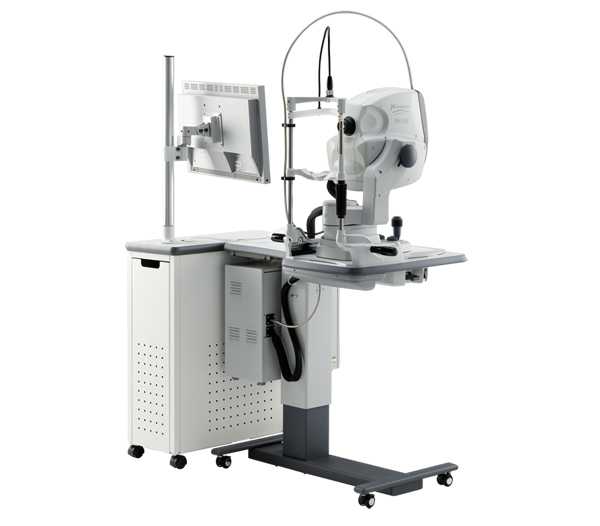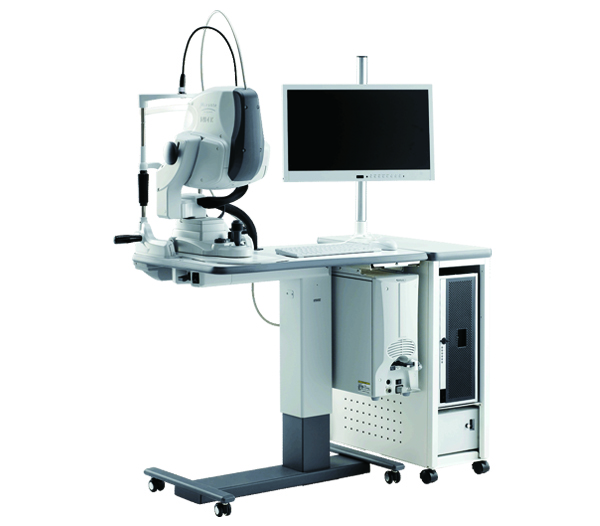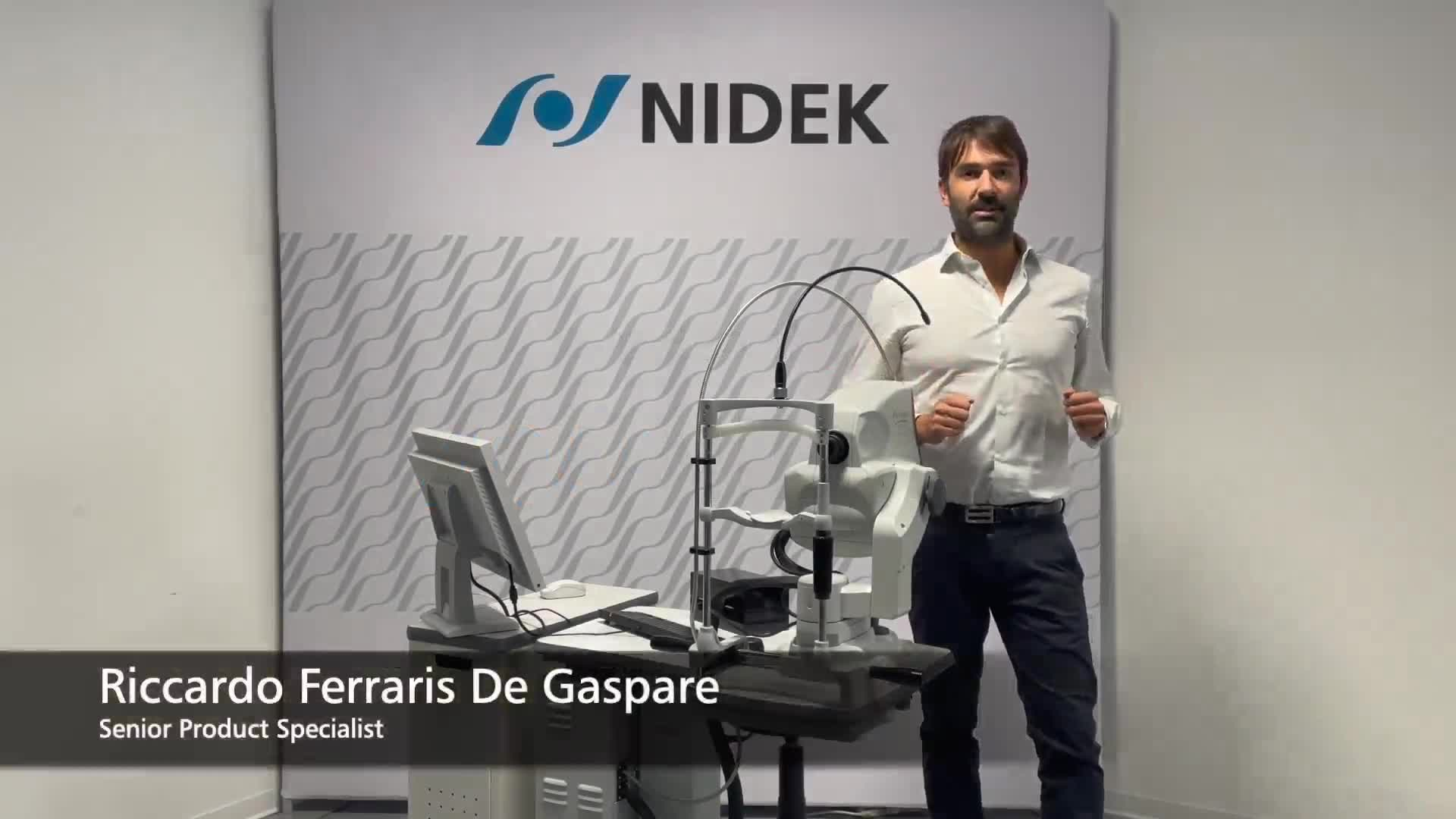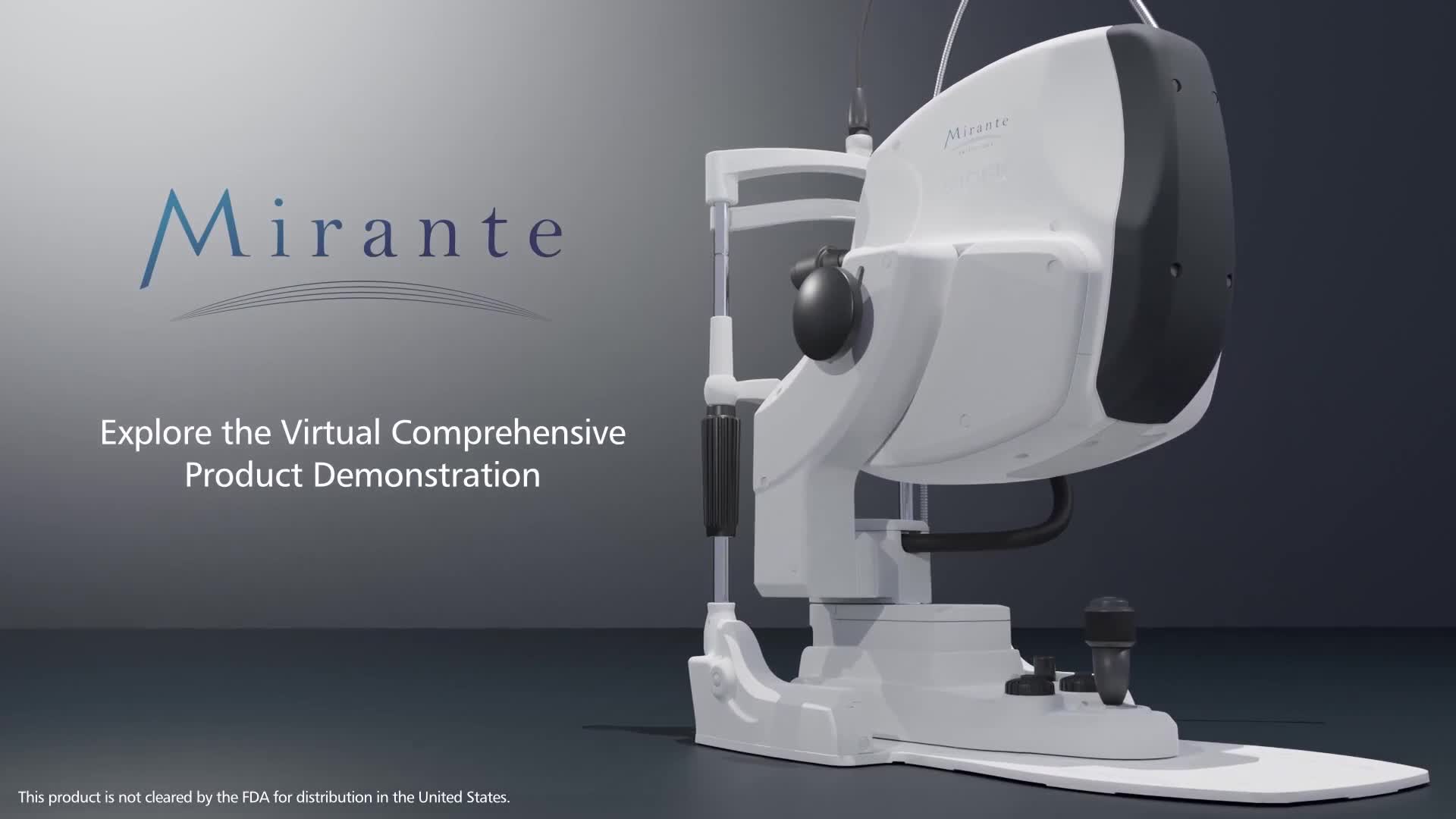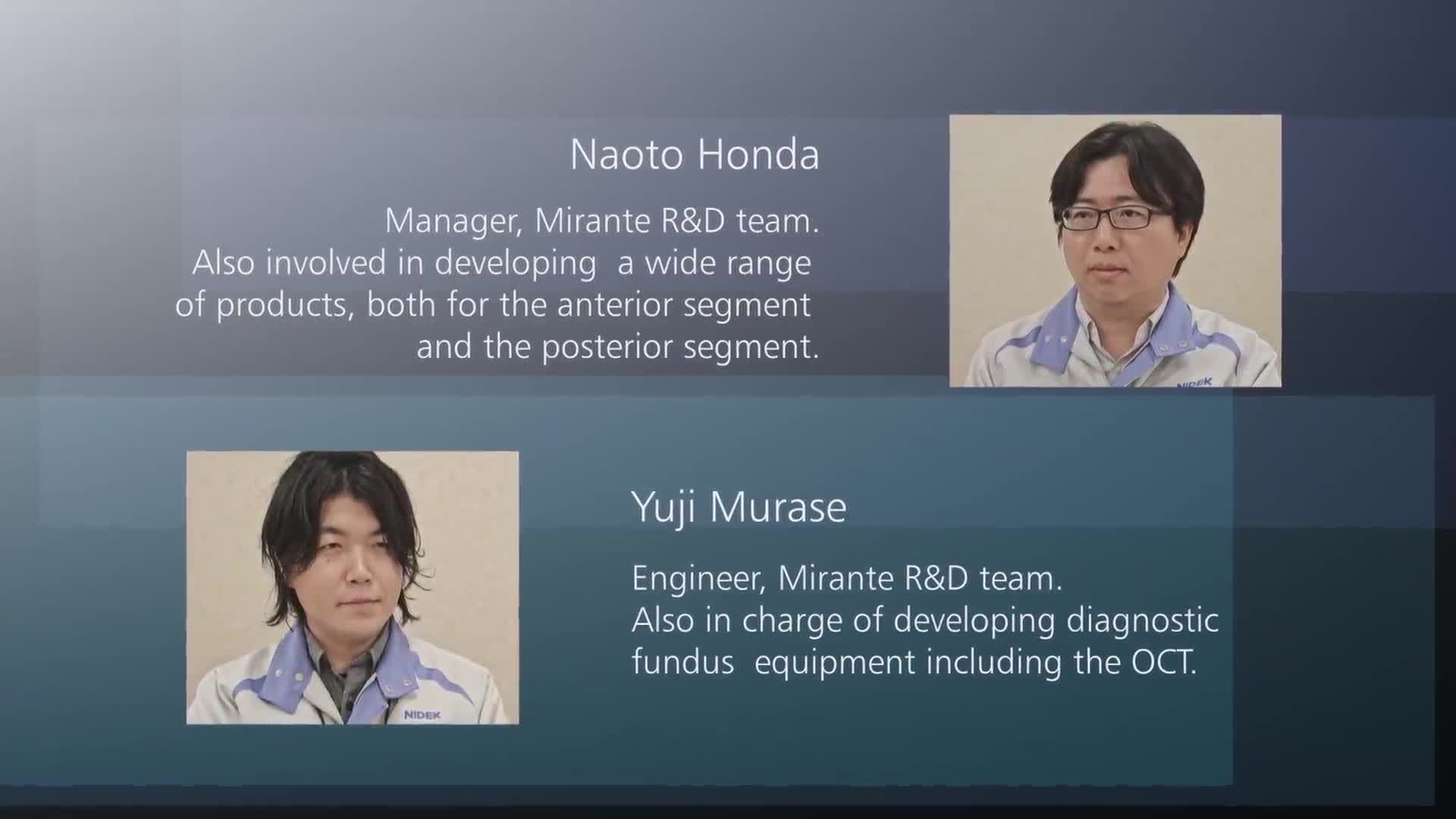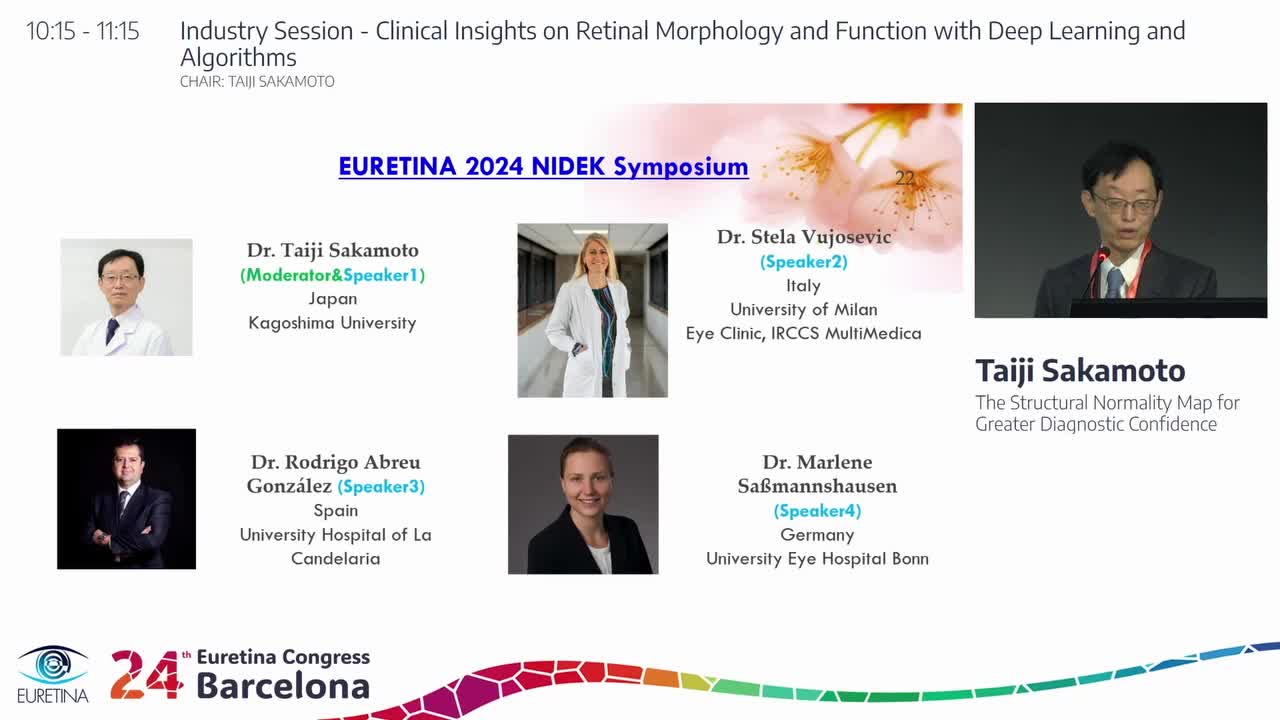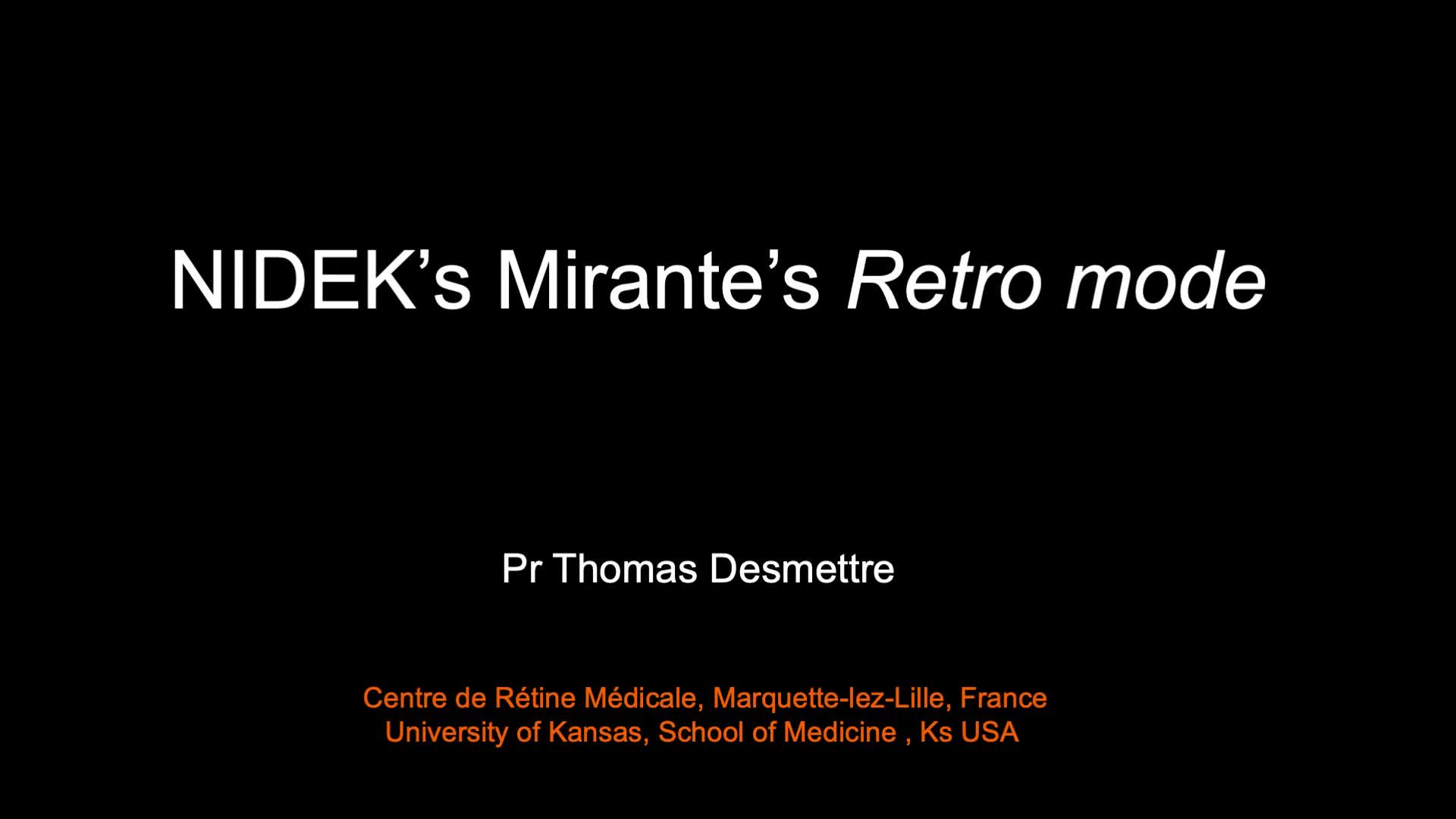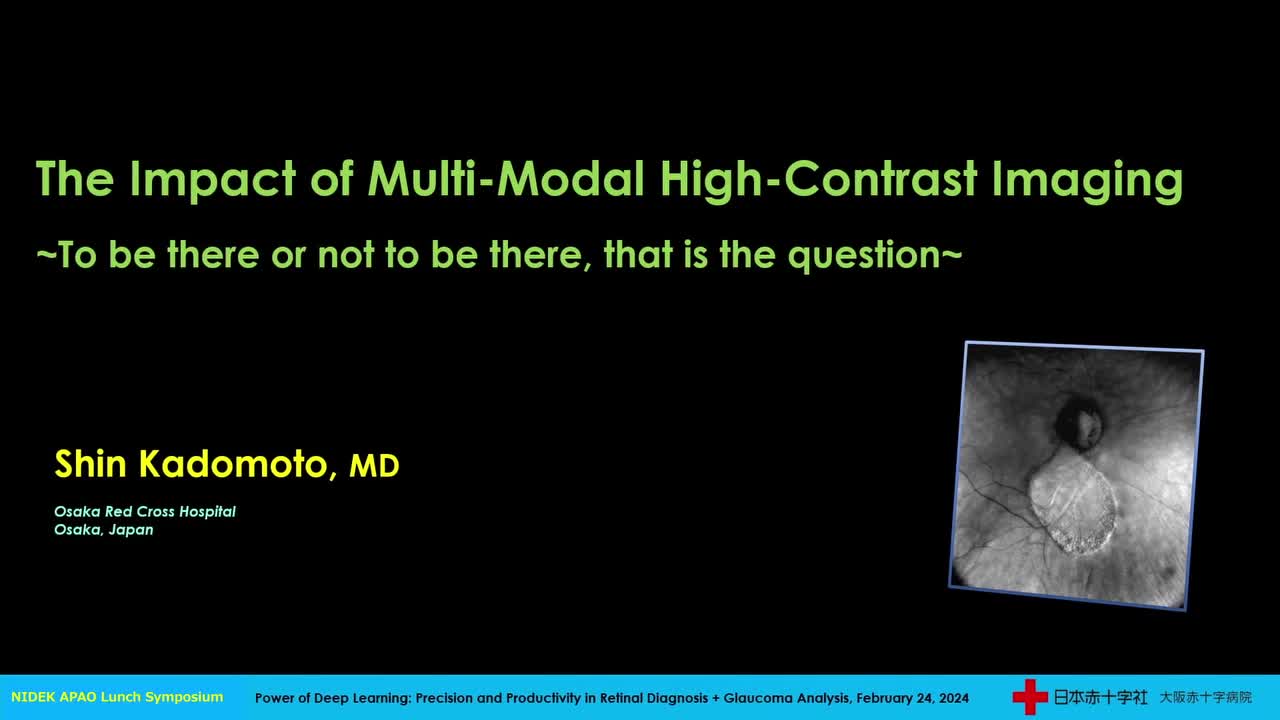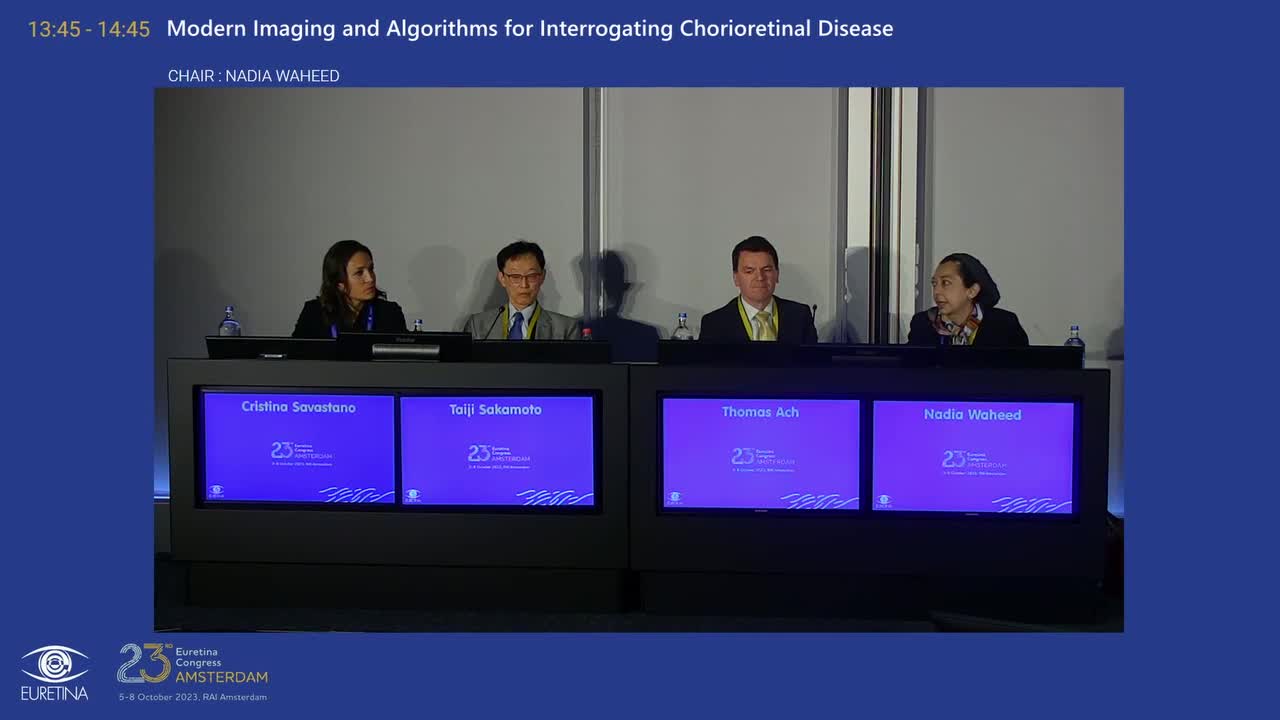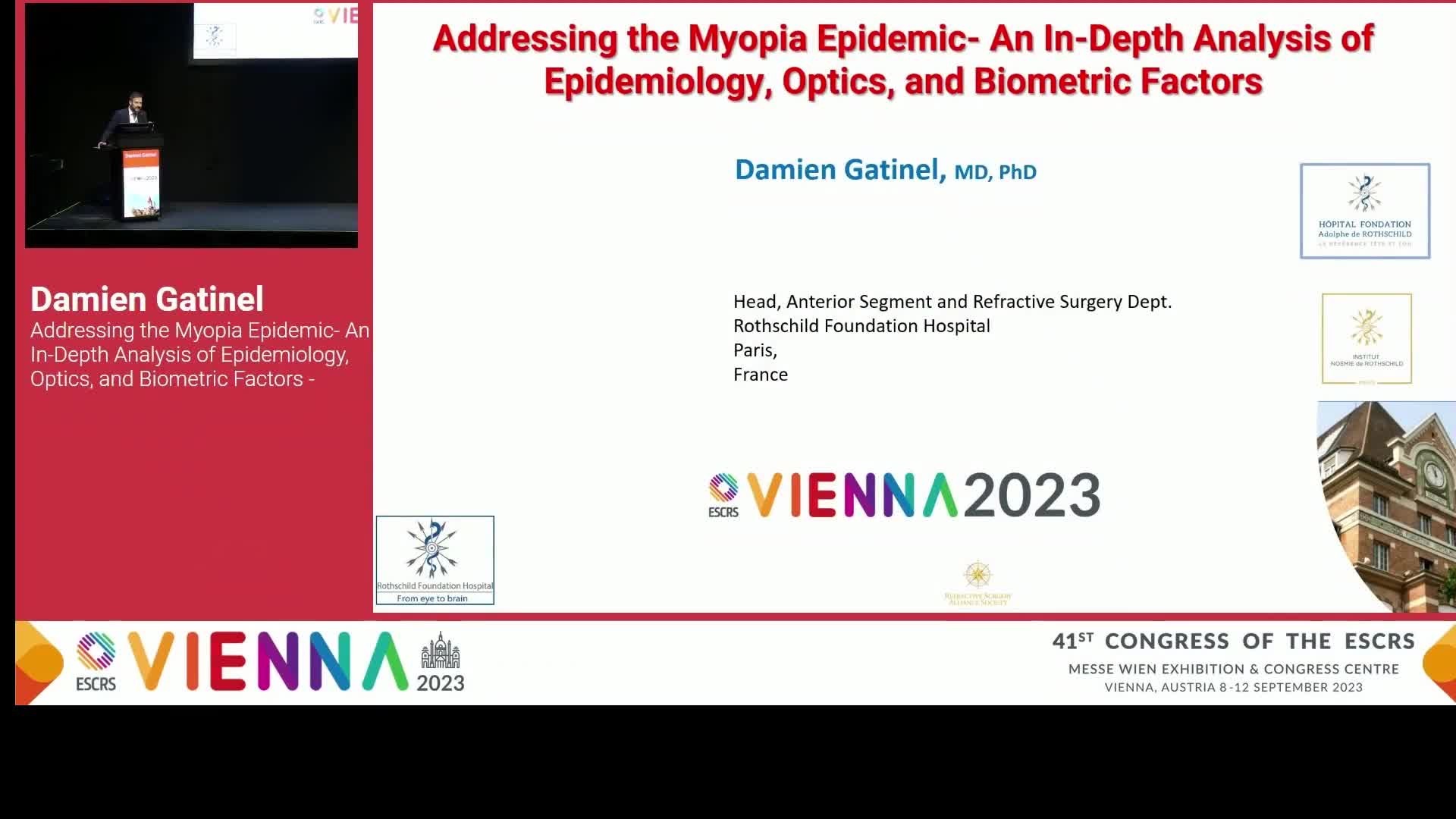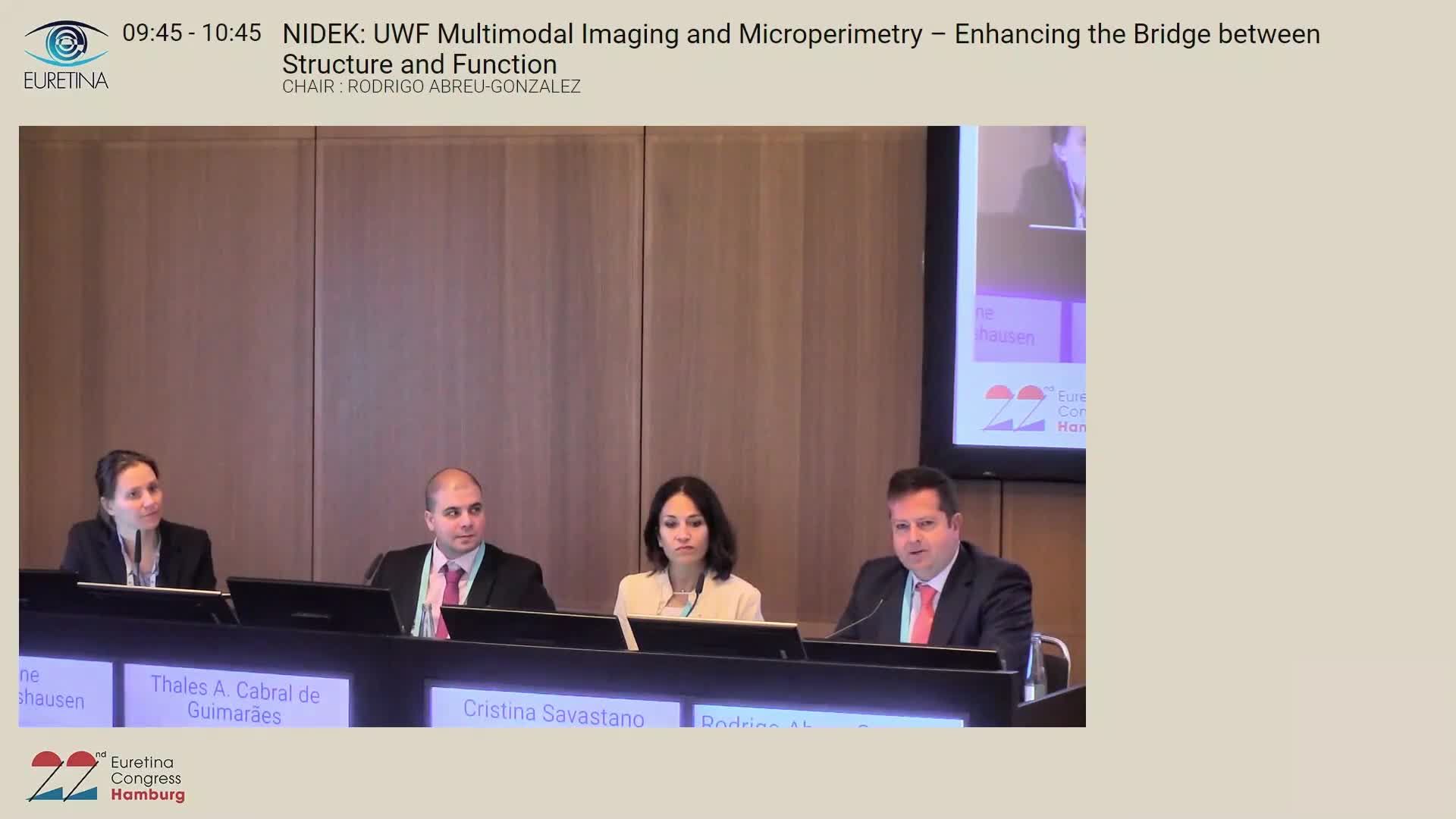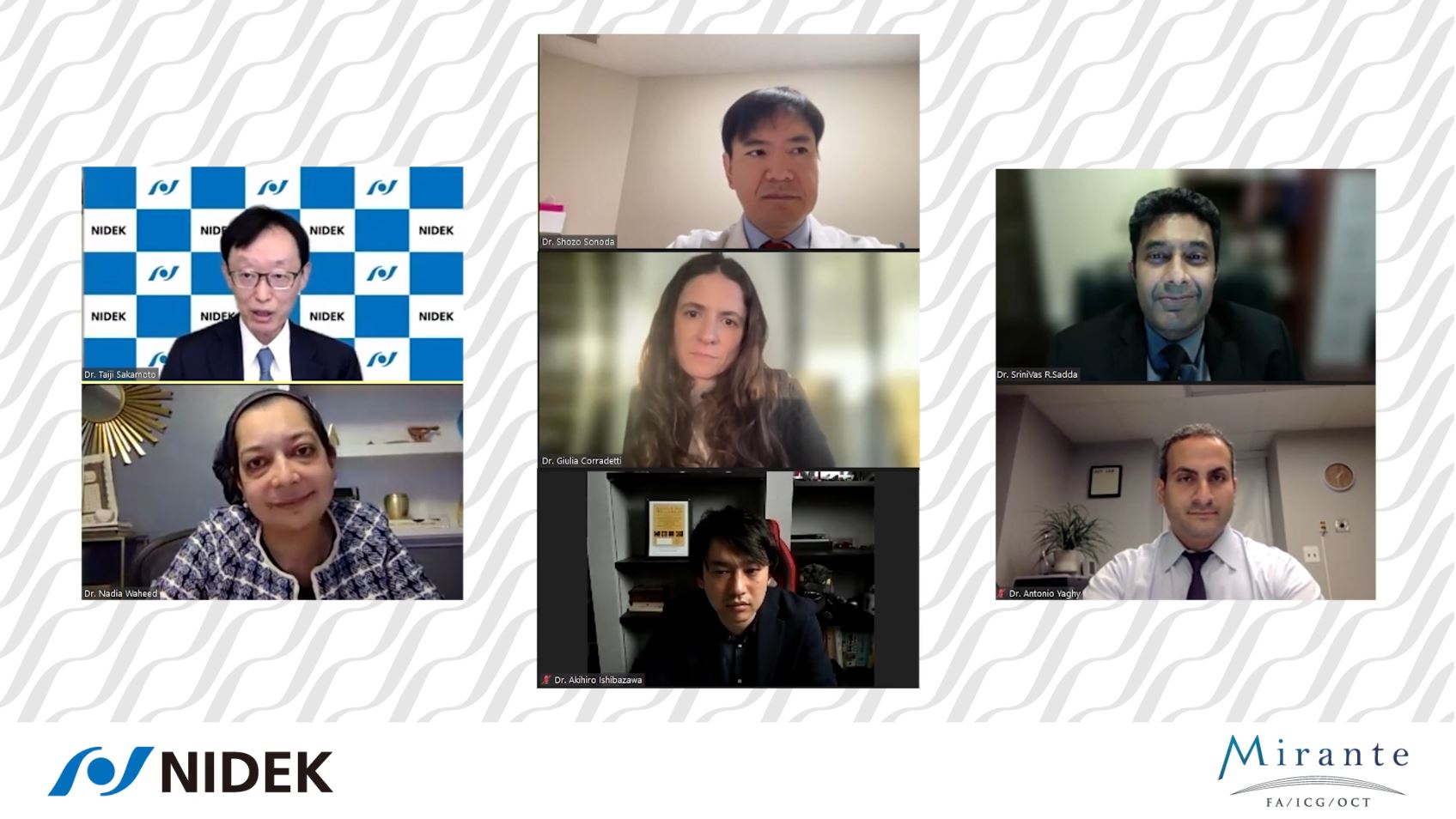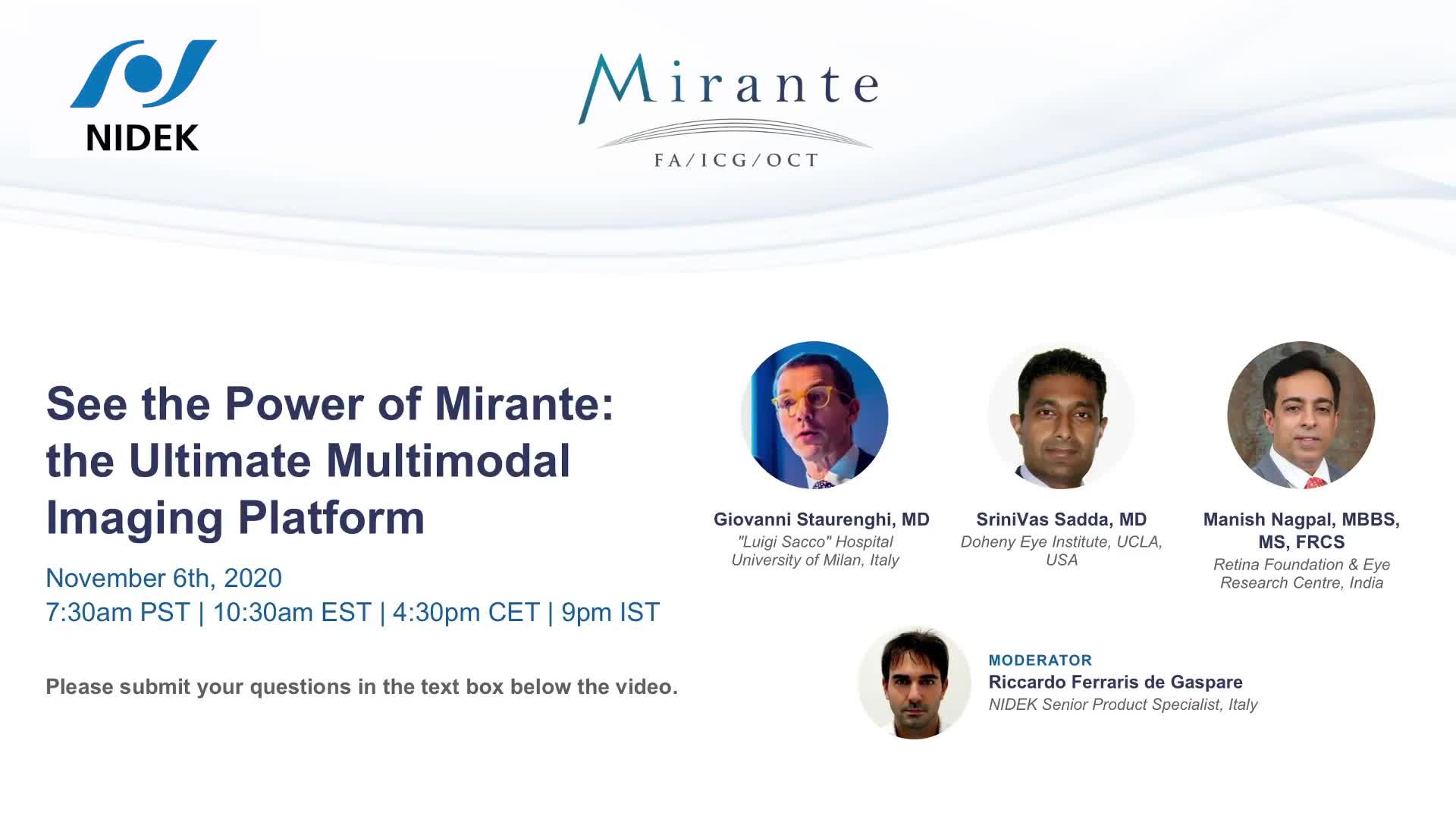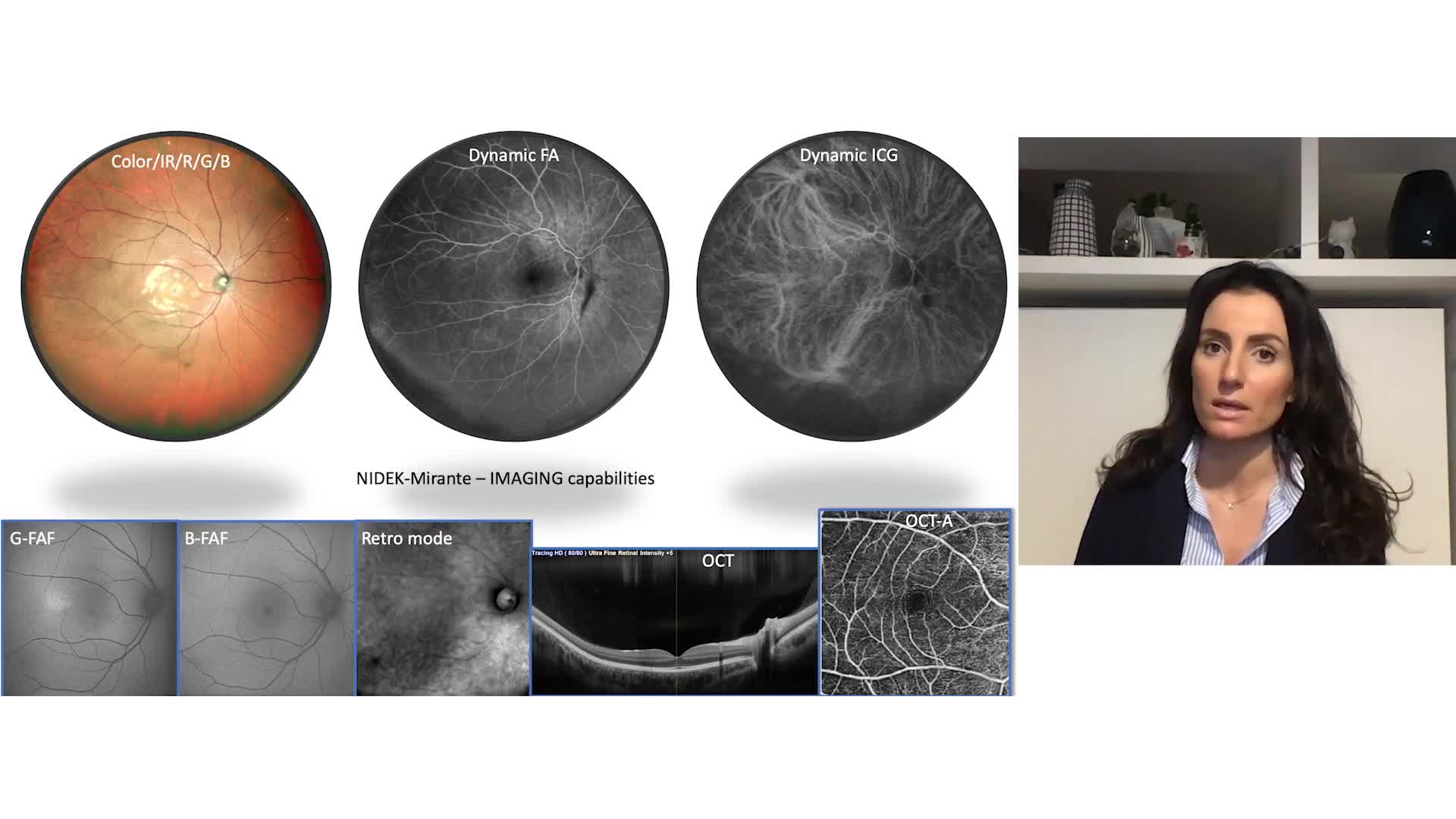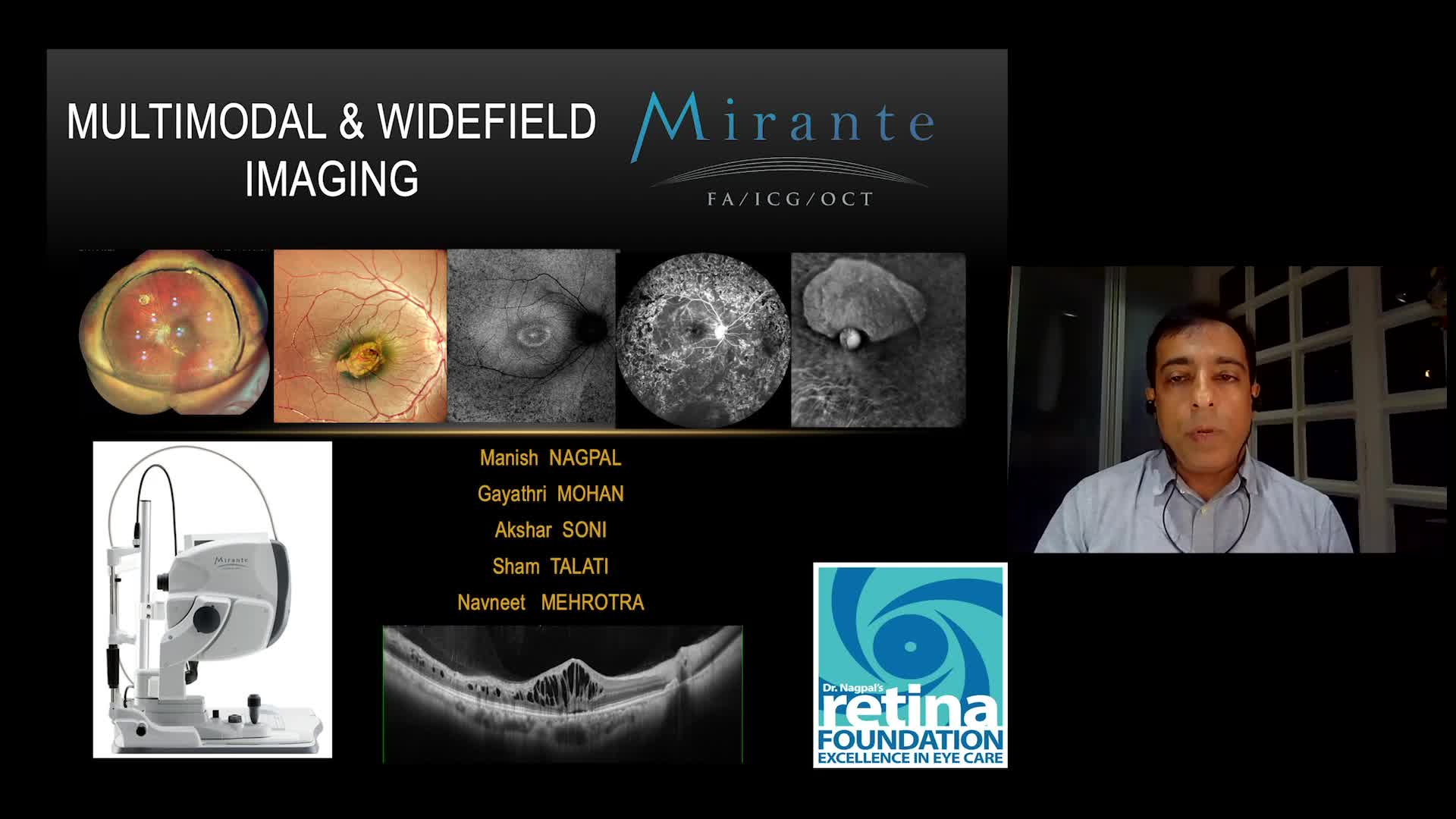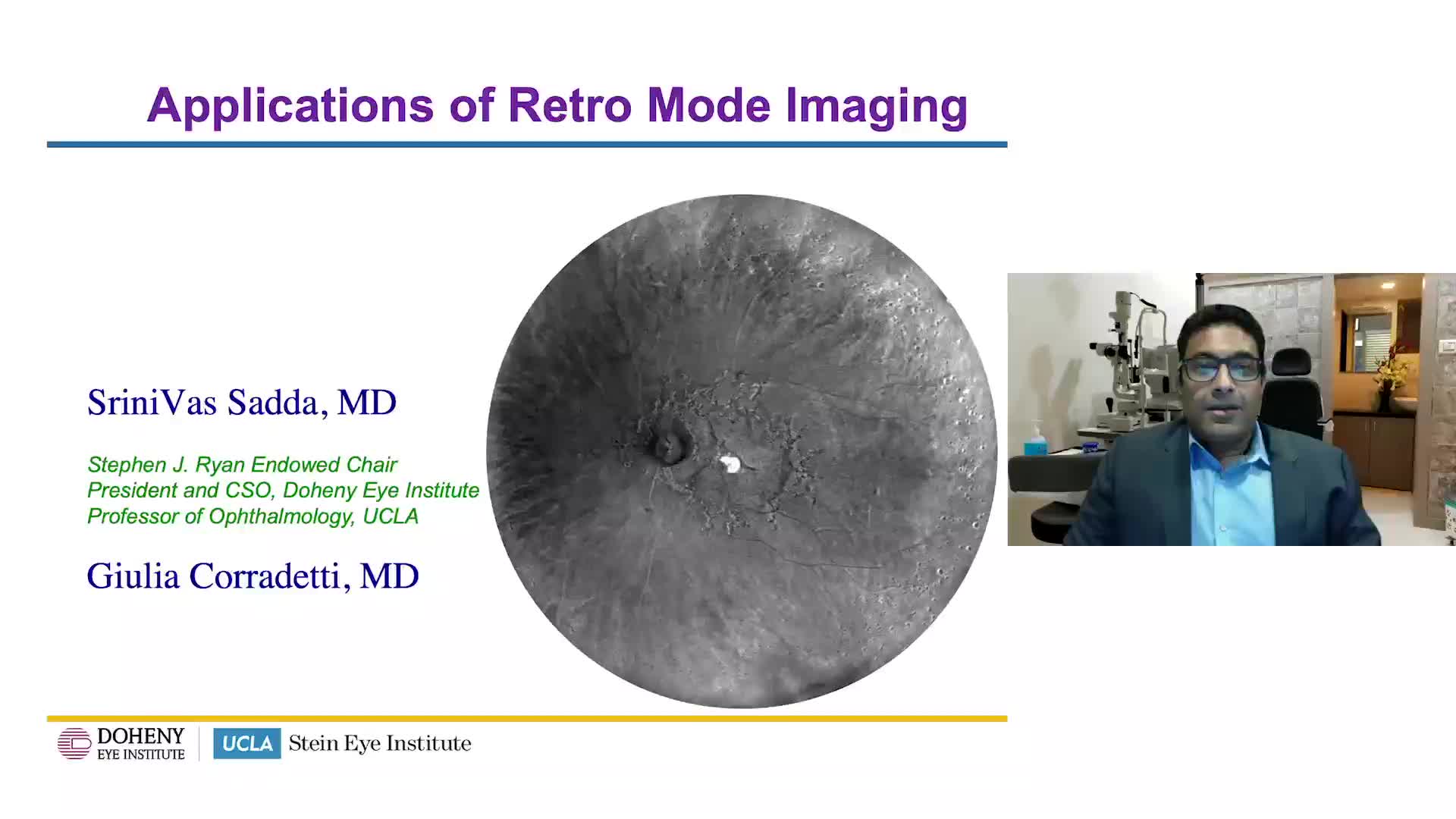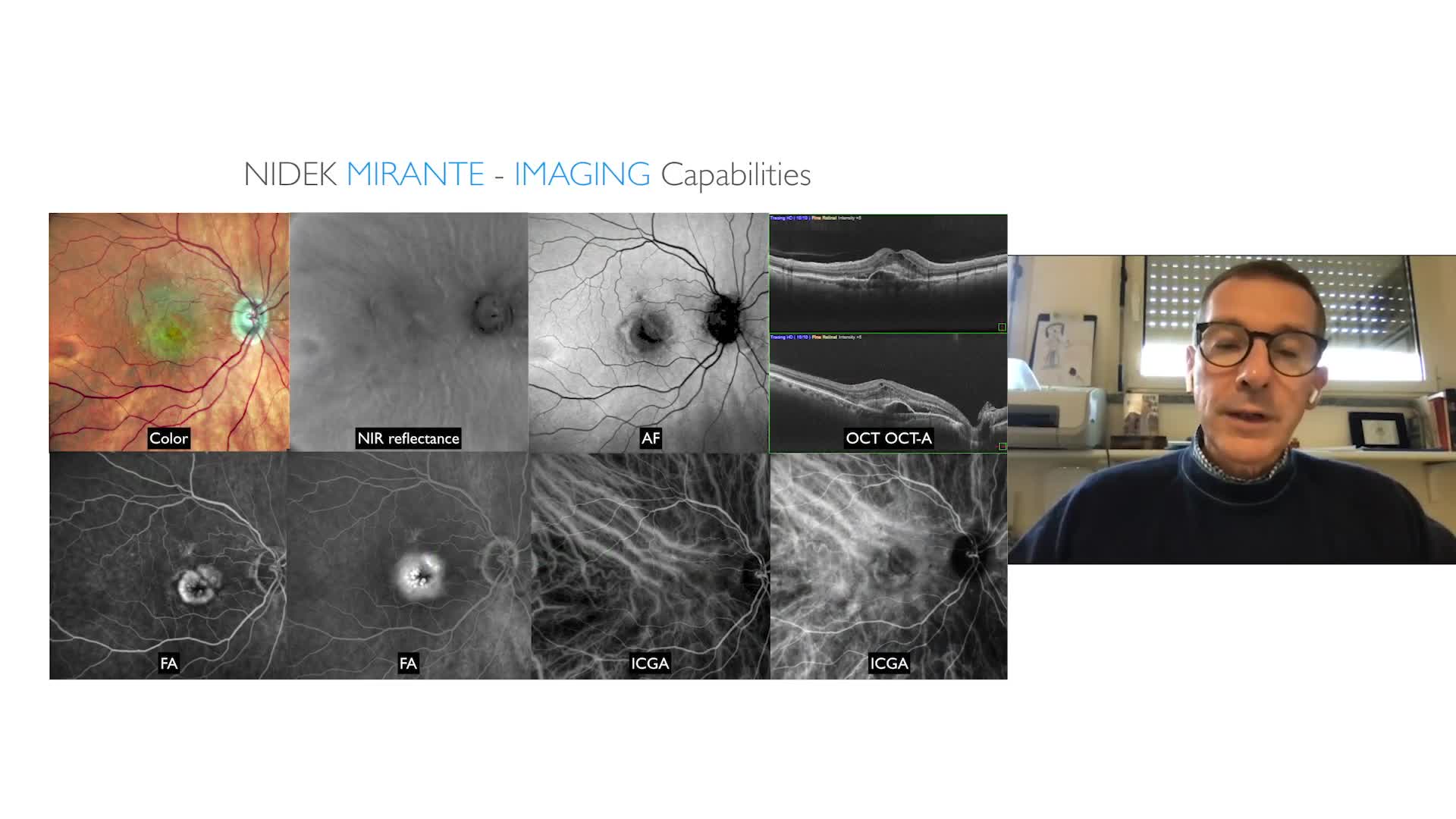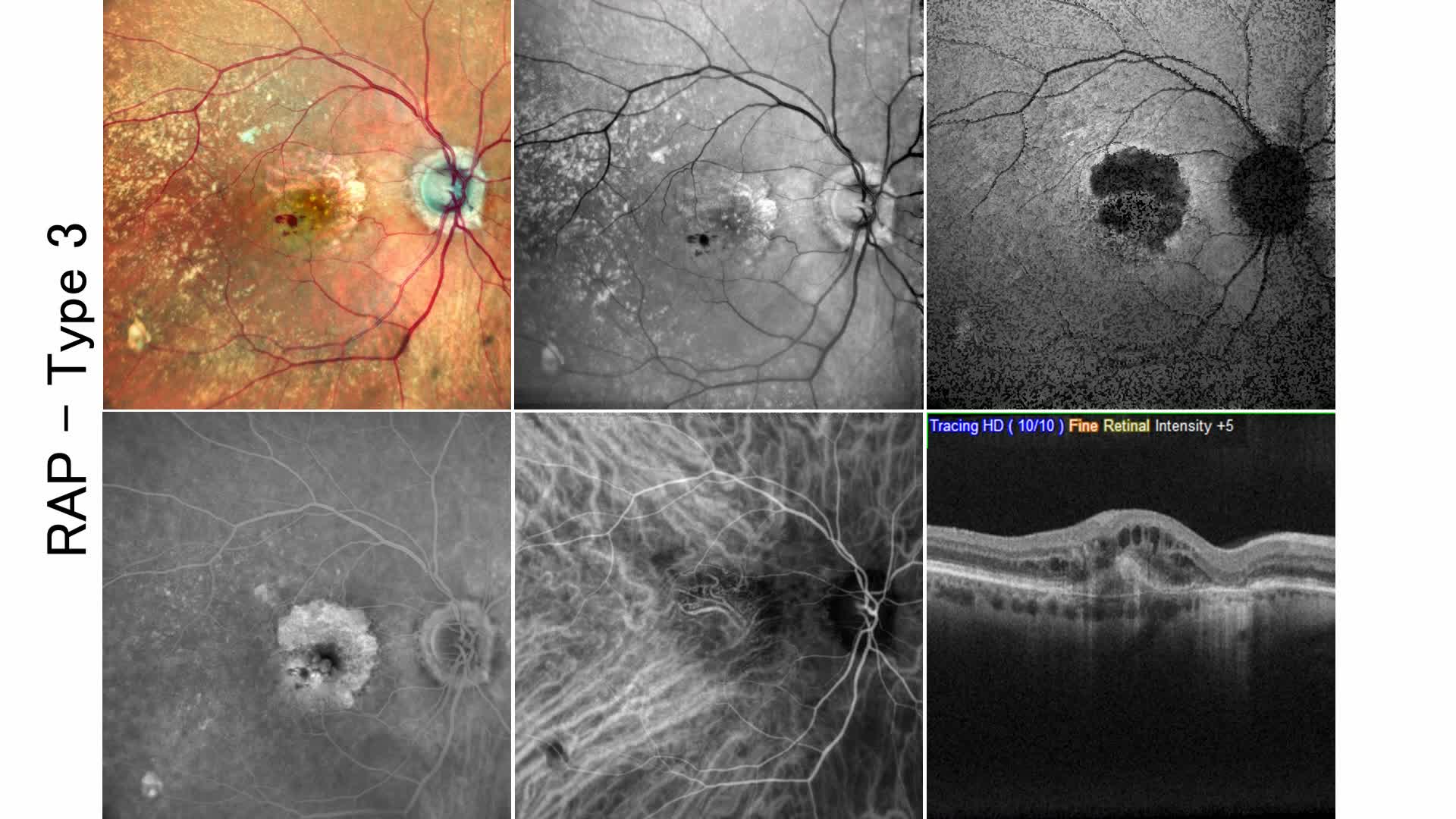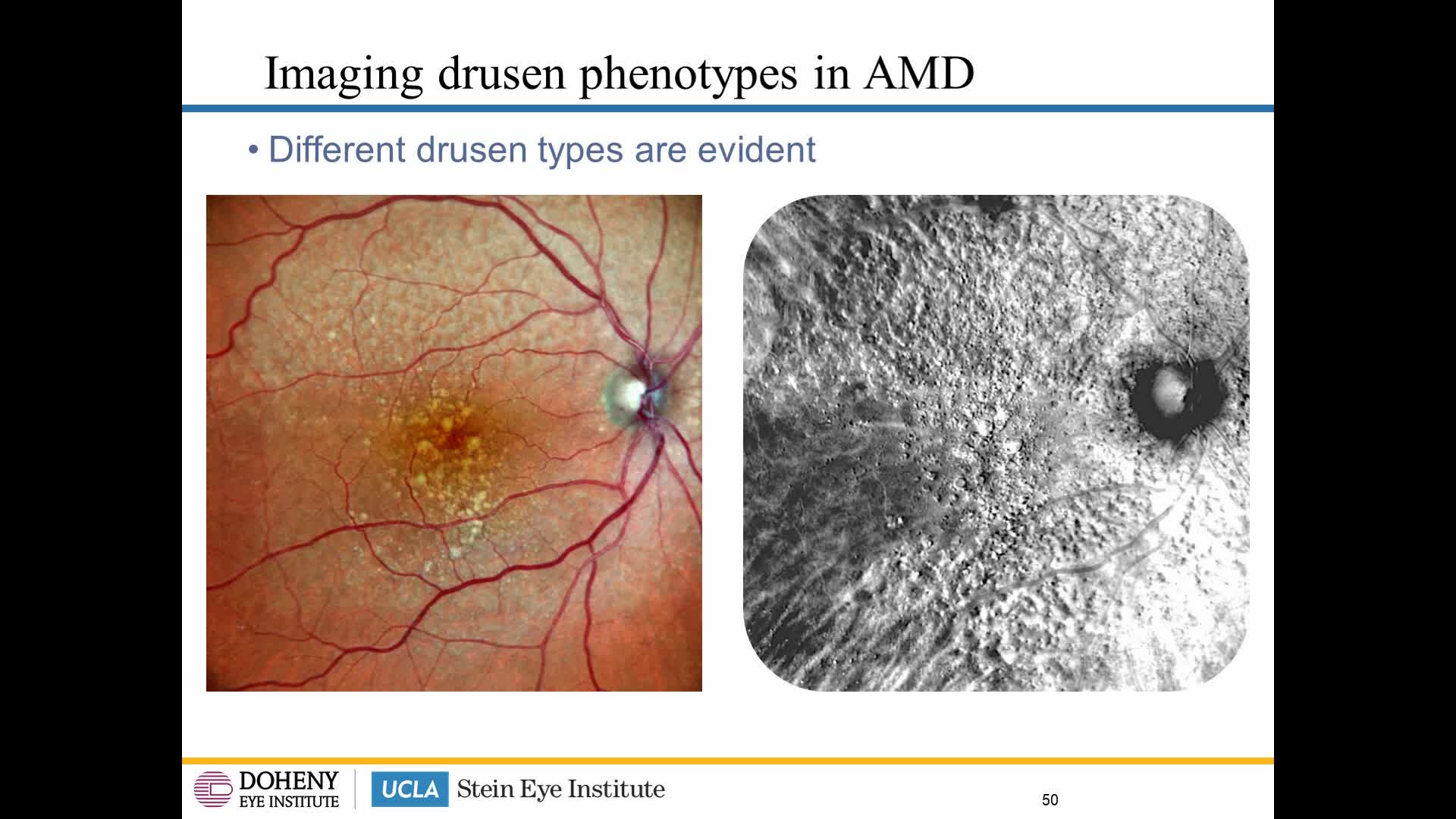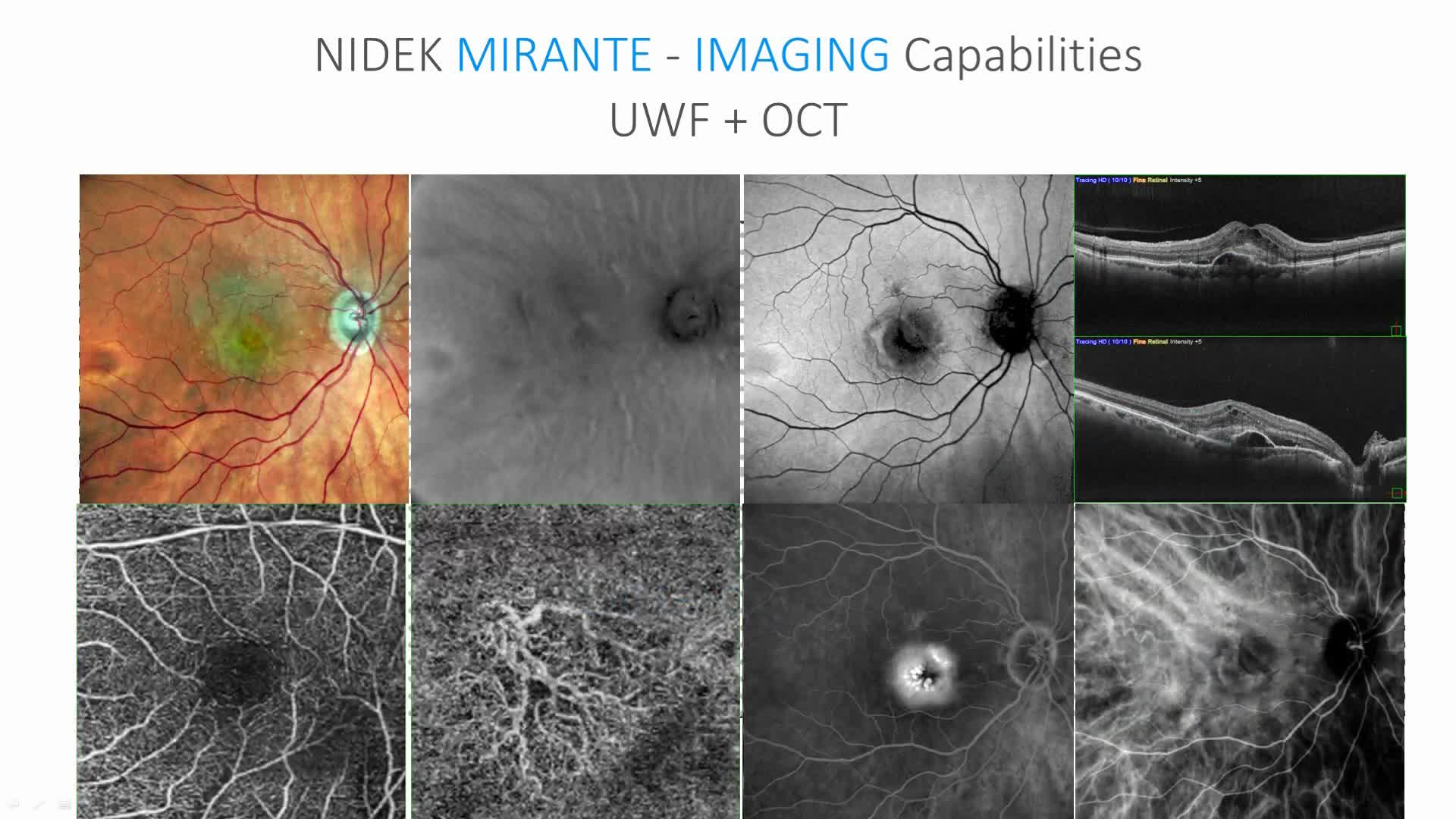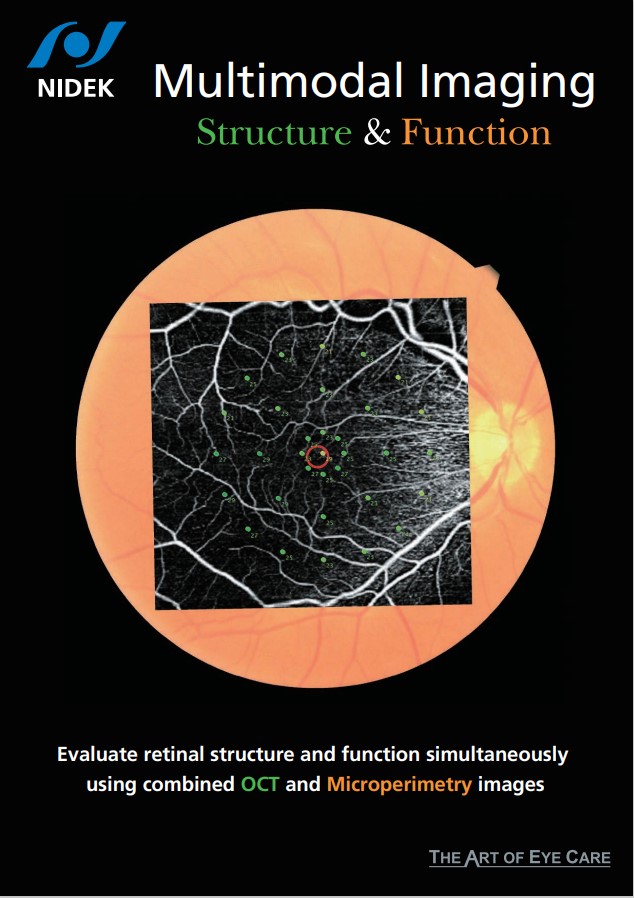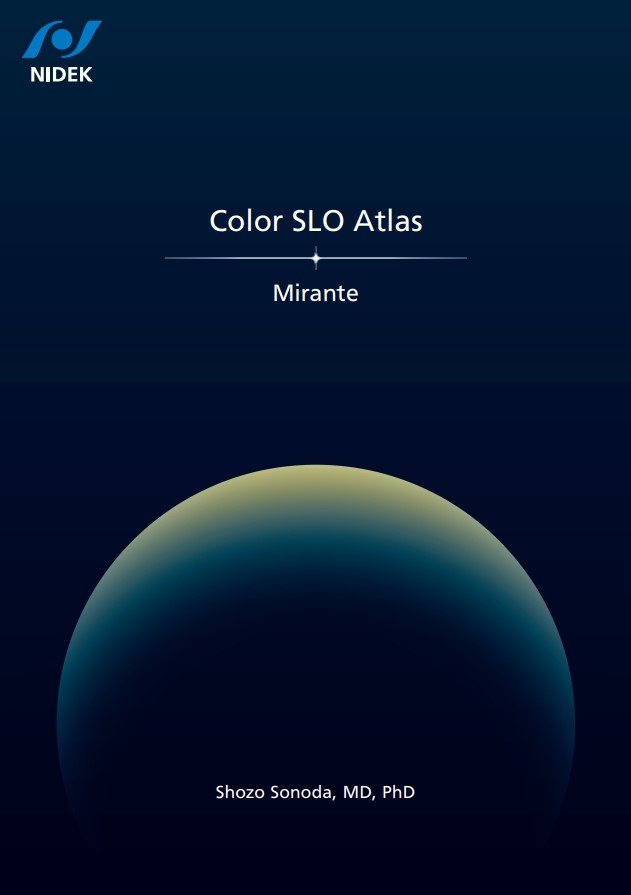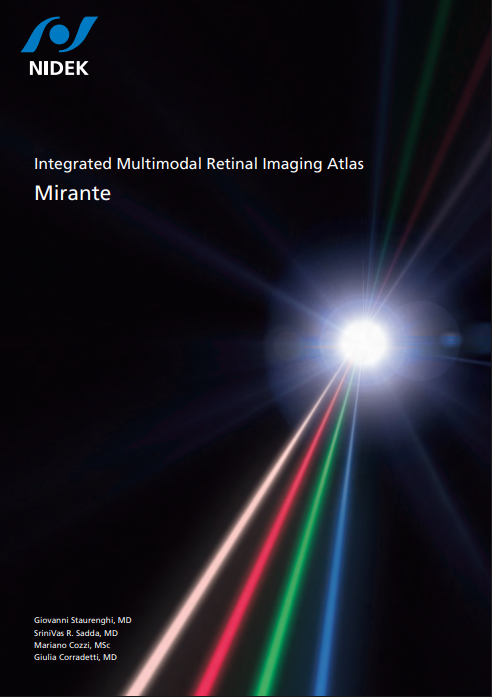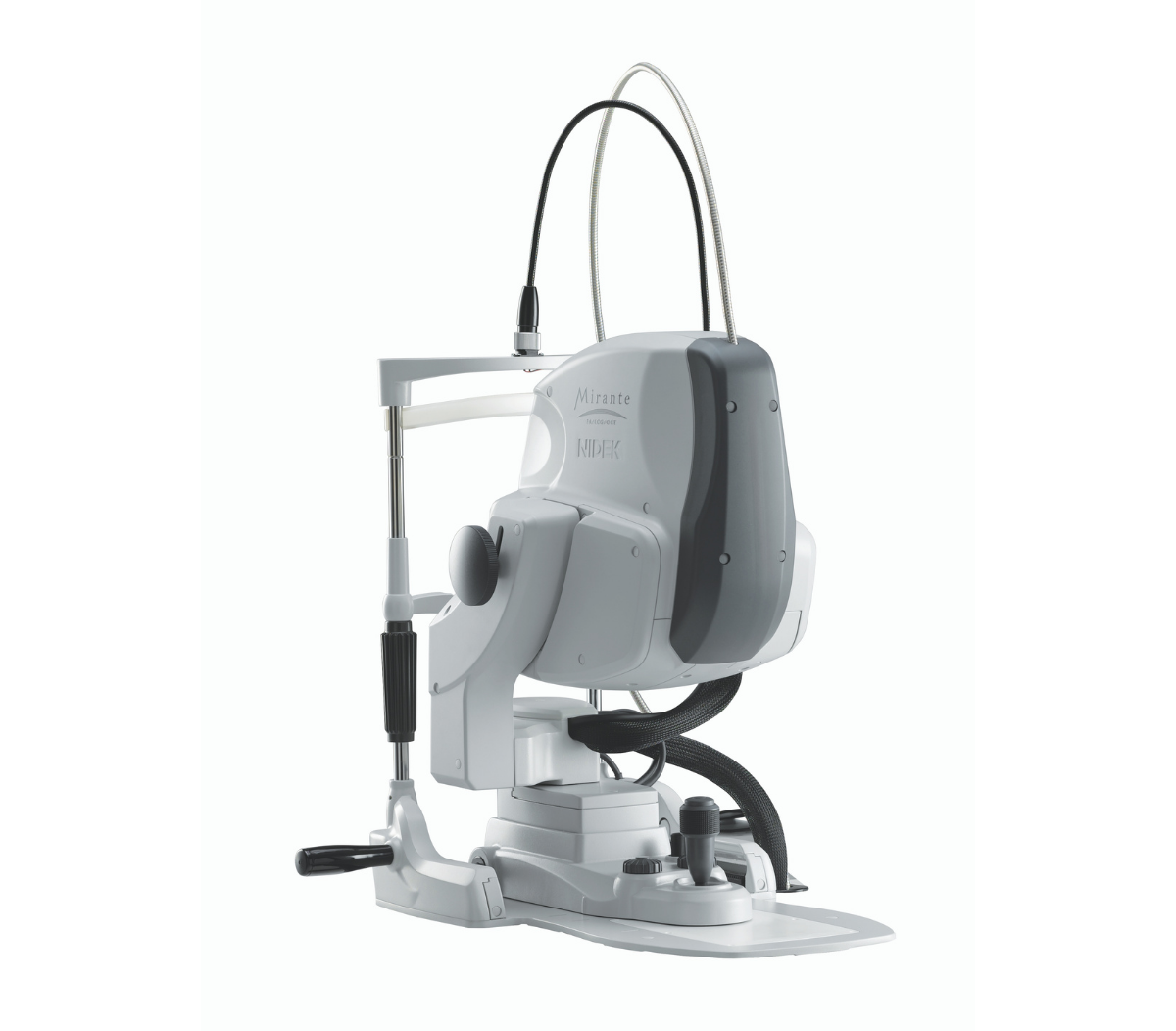
- La mejor plataforma de captura de imágenes multimodales
Mirante SLO/OCT:
-
- Modo a color/ FA / ICG/ FAF-Azul/ FAF-Verde/ Retro
- OCT/ Angiografía-OCT
Mirante SLO:
-
- Modo a color/ FA*/ ICG*/ FAF-Azul/ FAF-Verde/ Retro
- Campo ultra amplio vs. imagen ultra HD
- Color sin igual
- Dinámico/ simultáneo FA e ICG
- Modo retro exclusivo
- OCT de área amplia en HD
- Función Fly Through
*Opcional
Mirante SLO/OCT
Mirante SLO
La Última Plataforma de Imágenes Multimodales
Combo SLO & OCT de Última Generación
Campo Ultra Amplio x Imágen de Ultra Alta Definición
La combinación estelar de un campo ultra amplio de 163° x una ultra alta definición 4K de Mirante permite una visión más amplia y mejorada de la estructura y vasculatura de la retina con una claridad inigualable.
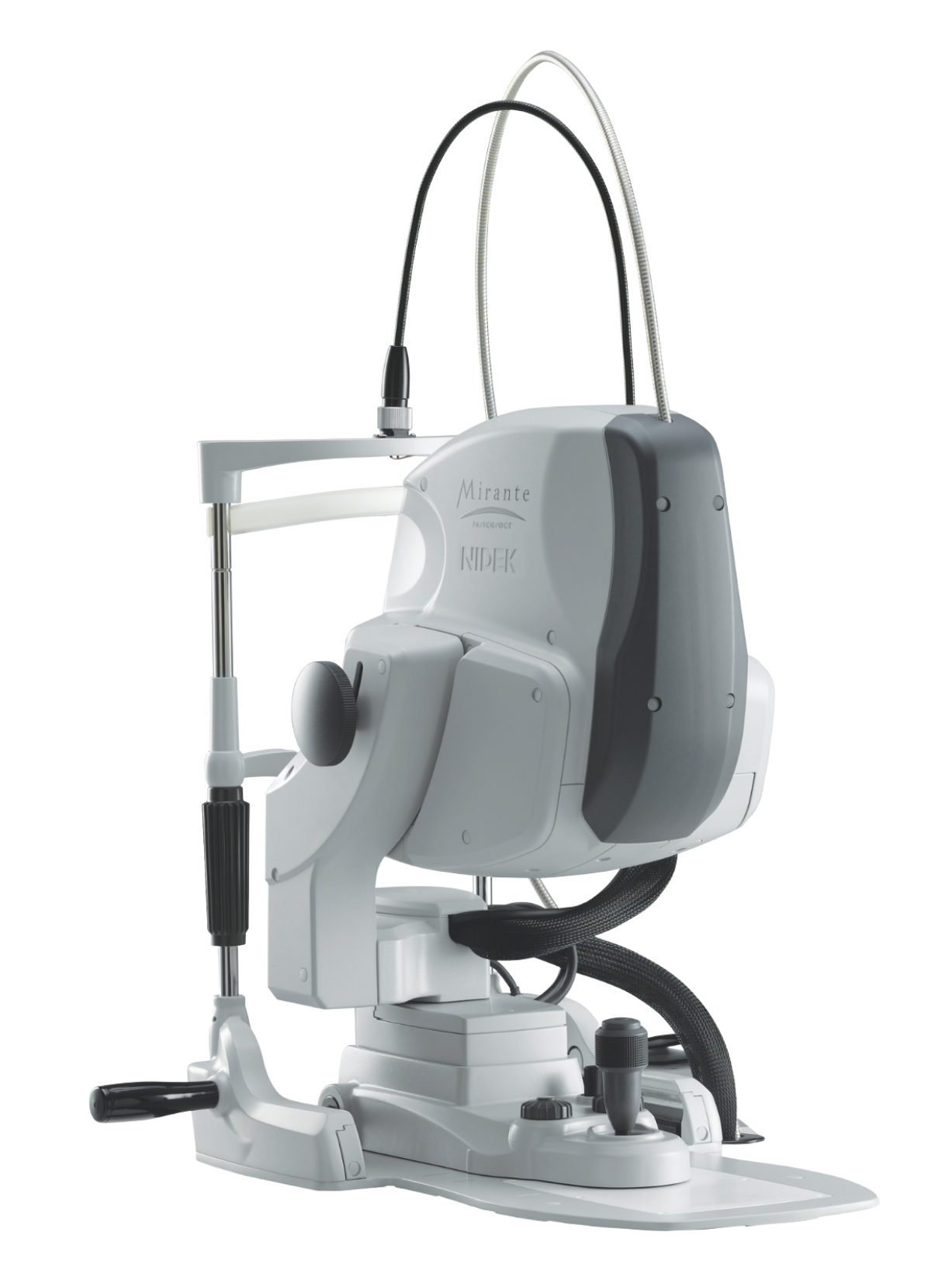
SLO a color
Claridad y color insuperable para cada detalle.
-
-
- Imagen a color de campo ultra amplio de 163 °
- Composición de imagen panorámica
- Detectores triples RGB
- Color RGB + pantalla de color seleccionable con un solo disparo
-
FlexTrack
El algoritmo FlexTrack corrige la distorsión de la imagen como consecuencia de una fijación inestable y mejora la calidad del promedio.
Modo Retro / FAF
Modalidades no invasivas de valor agregado que amplian su práctica.
-
-
- Modo retro
- FAF-Azul / FAF-Verde
(autofluorescencia del fondo de ojo)
-
FA e ICG
Evaluación efectiva del flujo sanguíneo dinámico y estático.
-
-
- Imágenes FA e ICG de campo ultra amplio de 163 °
- Angiograma dinámico y estático de alta definición
- FA e ICG simultáneamente
- Comparación sencilla de FA e ICG
-
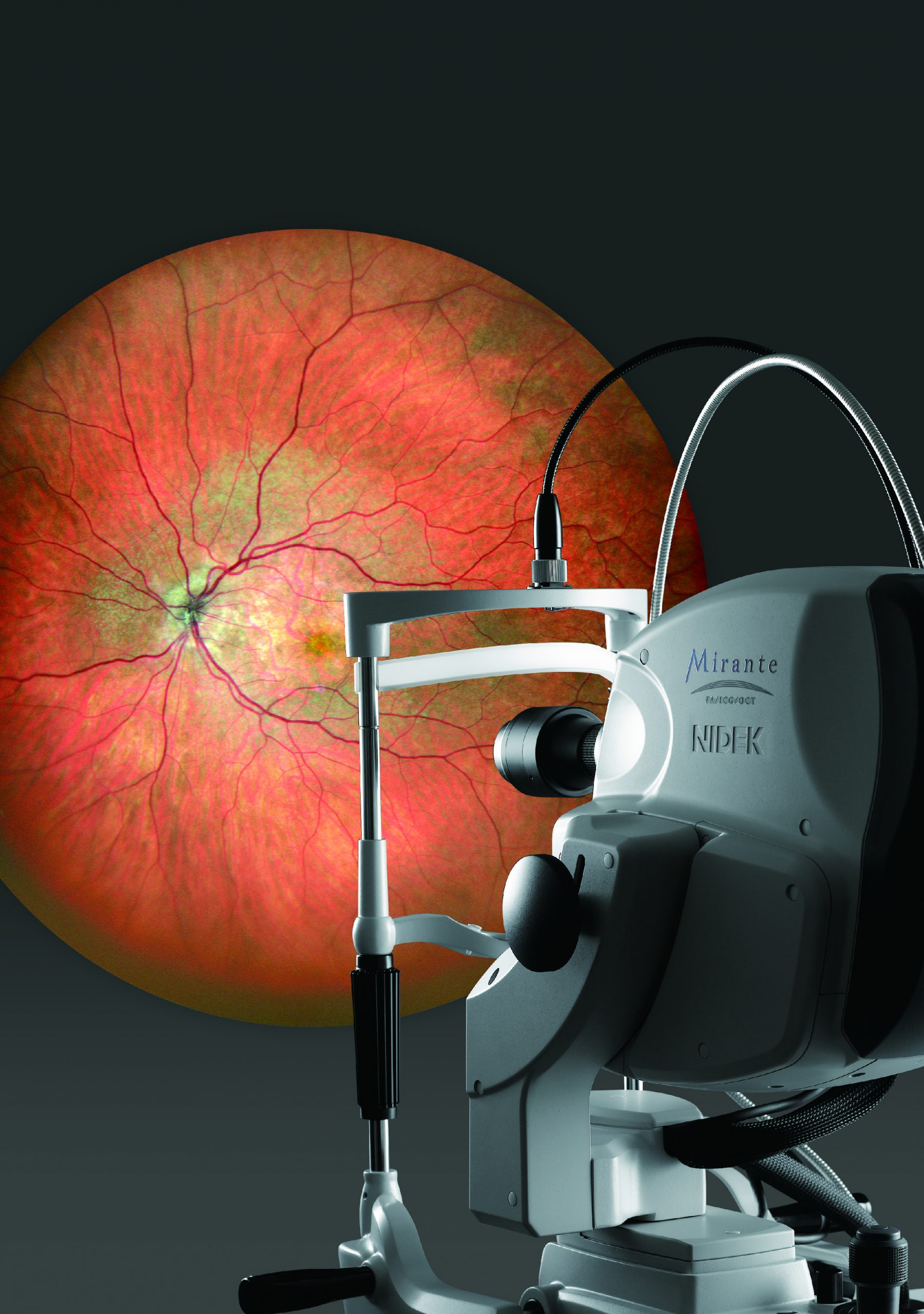
OCT
Imágenes de área amplia de alta definición de 16.5 x 12 mm con una gran variedad de funciones
-
- OCT de área amplia de alta definición
- Análisis del glaucoma
AngioScan
-
- Mapa de densidad de los vasos y mapa de densidad de perfusión
- Detección automática de FAZ y análisis de formas
- Escaneo de área amplia
- Rastreo HD plus
- Definición seleccionable
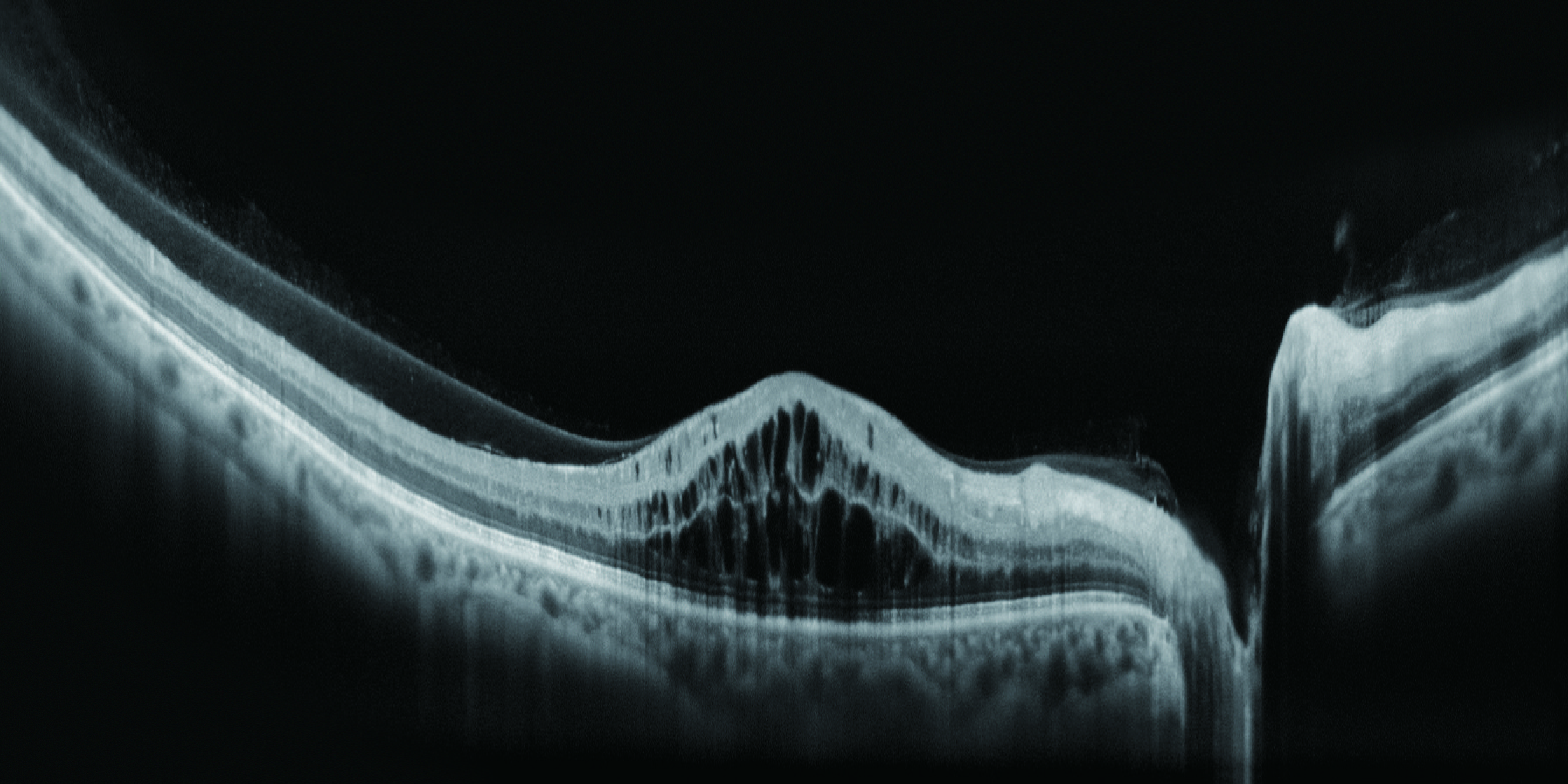
Para el modelo SLO/OCT:
Modo a color / FA / ICG / FAF-Azul / FAF-Verde / Retro
OCT / Angiografía-OCT*
Para el modelo SLO:
Modo a color / FA*/ ICG* / FAF-Azul / FAF-Verde / Retro
*Opcional
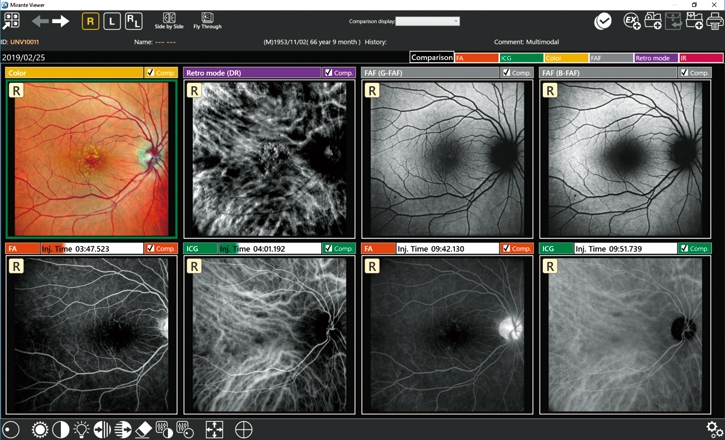
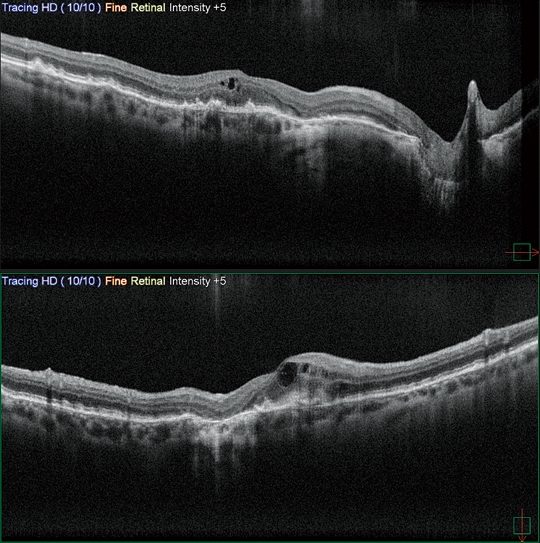
Captura de imagen de combinación simplificada
La captura de imágenes combinada permite la captura secuencial de imágenes con la combinación predefinida de configuraciones de captura de imágenes para cada enfermedad específica.
Imagen de campo ultra amplio de 163 °
La imagen nítida de todo el campo de visión de 163° permite una evaluación detallada de las patologías desde la fóvea hasta la periferia extrema.
(Las imágenes de campo ultra amplio están disponibles con el adaptador de campo amplio opcional).

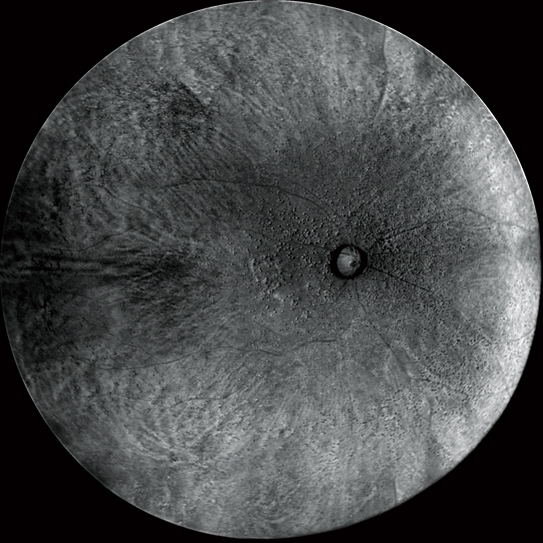
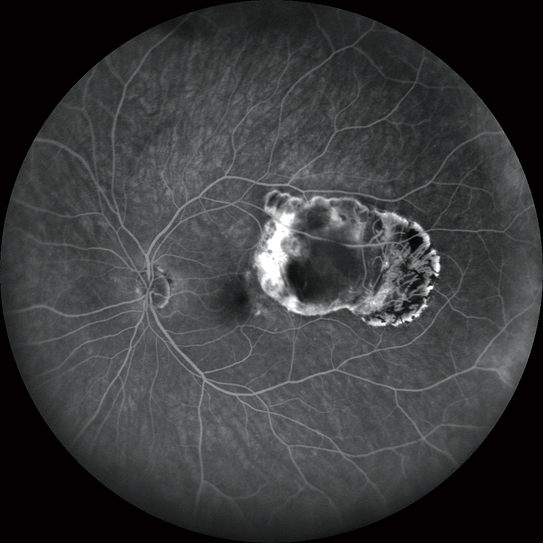
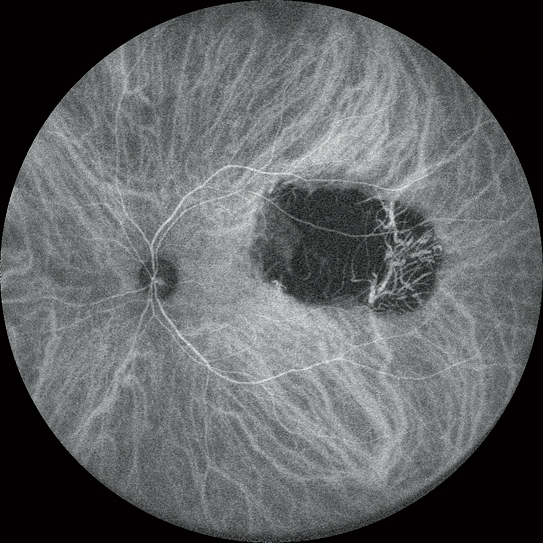
Ultra 4K HD y función multimedia para una claridad inigualable
Las imágenes de 4.096 x 4.096 píxeles capturan todos los detalles de la retina y la coroides. Además, el zoom permite una gran ampliación, visualización clara de cambios sutiles en la patología y resolución de detalles capilares finos.
El algoritmo FlexTrack corrige la distorsión de la imagen debido a una fijación inestable y mejora la calidad de los medios.
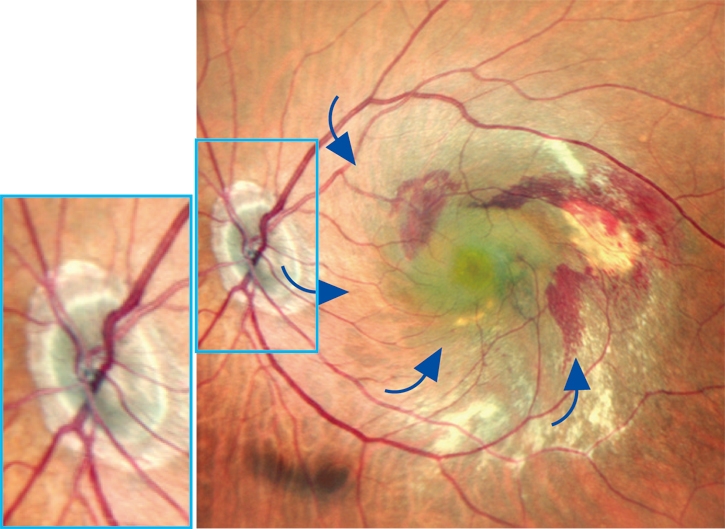
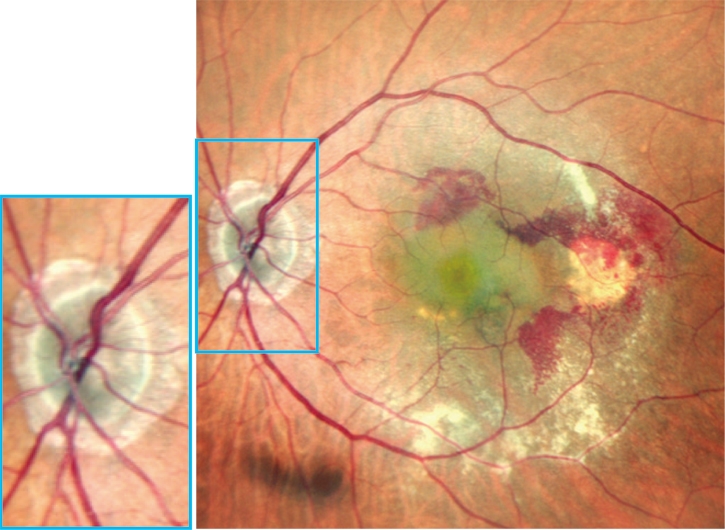
Tres detectores RGB separados exploran simultáneamente diferentes profundidades de la retina con longitudes de onda rojas, verdes y azules. Un histograma de color está disponible para un ajuste fino basado en patología o preferencia del profesional.

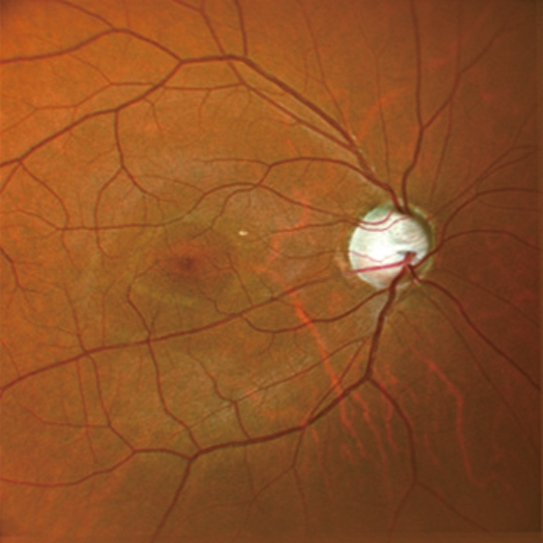
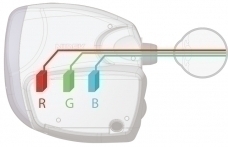
HD angiograma dinámico
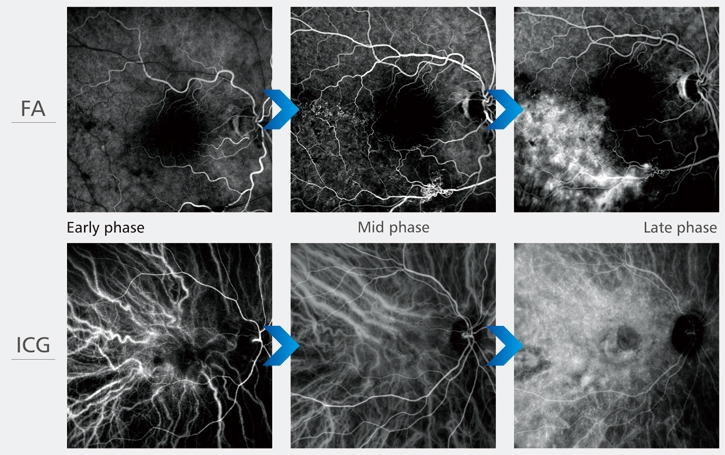
Los videos se pueden grabar con un máximo de 1,024 x 1,024 píxeles por hasta 120 segundos. Se pueden grabar varios videos cortos durante la misma medición.
FA e ICG simultáneos
El punto de vista permite la obtención simple y simultánea de imágenes AF e ICG.
La monitorización IR en vivo permite la alineación antes de la emisión de fluorescencia y reduce el riesgo de perder una etapa muy temprana de la angiografía.
El control automático de ganancia (AGC) ajusta simultáneamente el contraste de cada imagen de AF e ICG, haciendo que la captura de imágenes dinámicas de flujo sanguíneo sea muy simple.
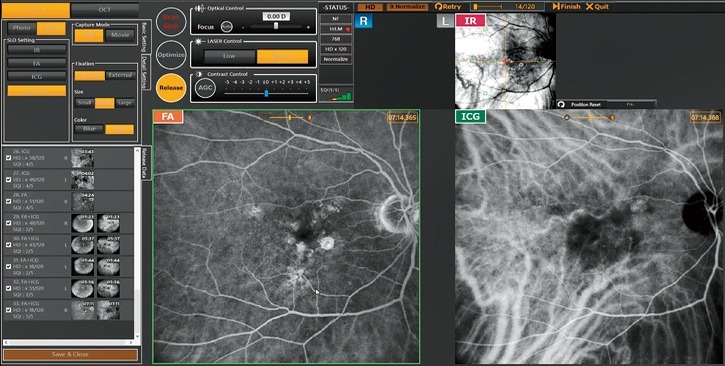
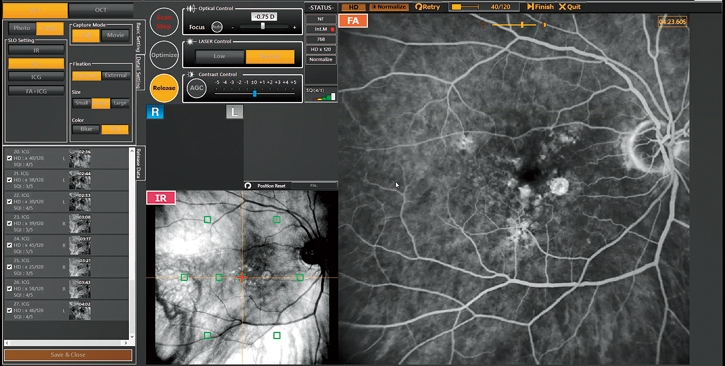

El modo retro es una técnica no invasiva única para detectar cambios patológicos en la coroides.
Este modo de captura de imágenes utiliza luz infrarroja dispersa para detectar reflejos coroideos anormales causados por drusas, edemas y otras patologías coriorretinianas sutiles.
Imágenes coloridas y retro (Drusen)
El Retina map permite el diagnóstico de un área amplia, incluida la mácula y el disco óptico en una sola toma. El modo ultrafino y las funciones de seguimiento HD plus proporcionan imágenes de alta calidad para la observación detallada del vítreo a la coroides.
* Imágenes cortesía del Hospital Luigi Sacco, Universidad de Milán, Italia / Fundación Retina y Centro de Investigación Oftálmica, India

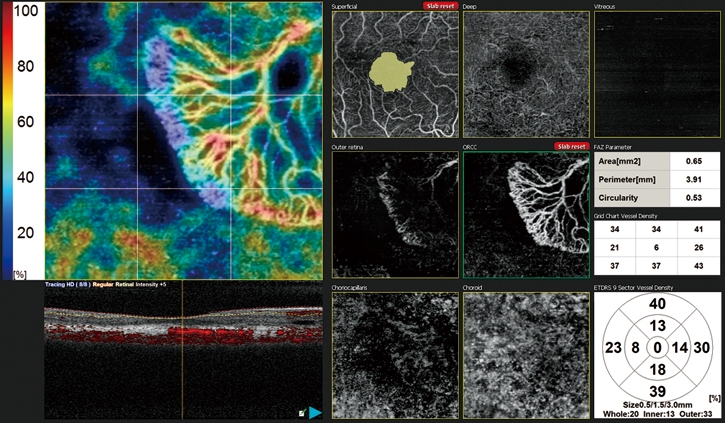
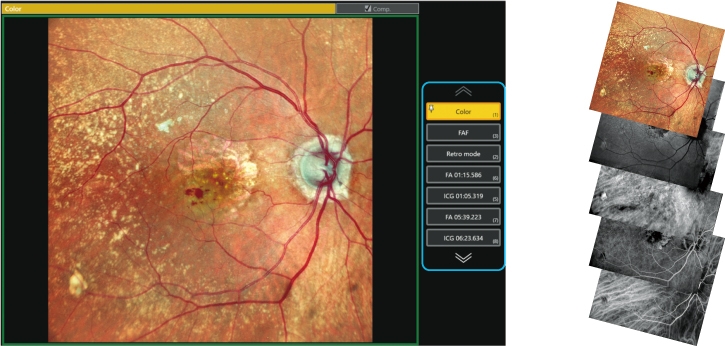
La función “Fly Through” mejora aún mas las imágenes multimodales al registrar y sincronizar imágenes de diferentes modalidades, con el fin de visualizar la misma área mientras se desplaza por la región de interés.
Se pueden registrar varias modalidades de OCT con microperimetría capturada por el MP-3 de NIDEK.
* Disponible para el modelo SLO/OCT.

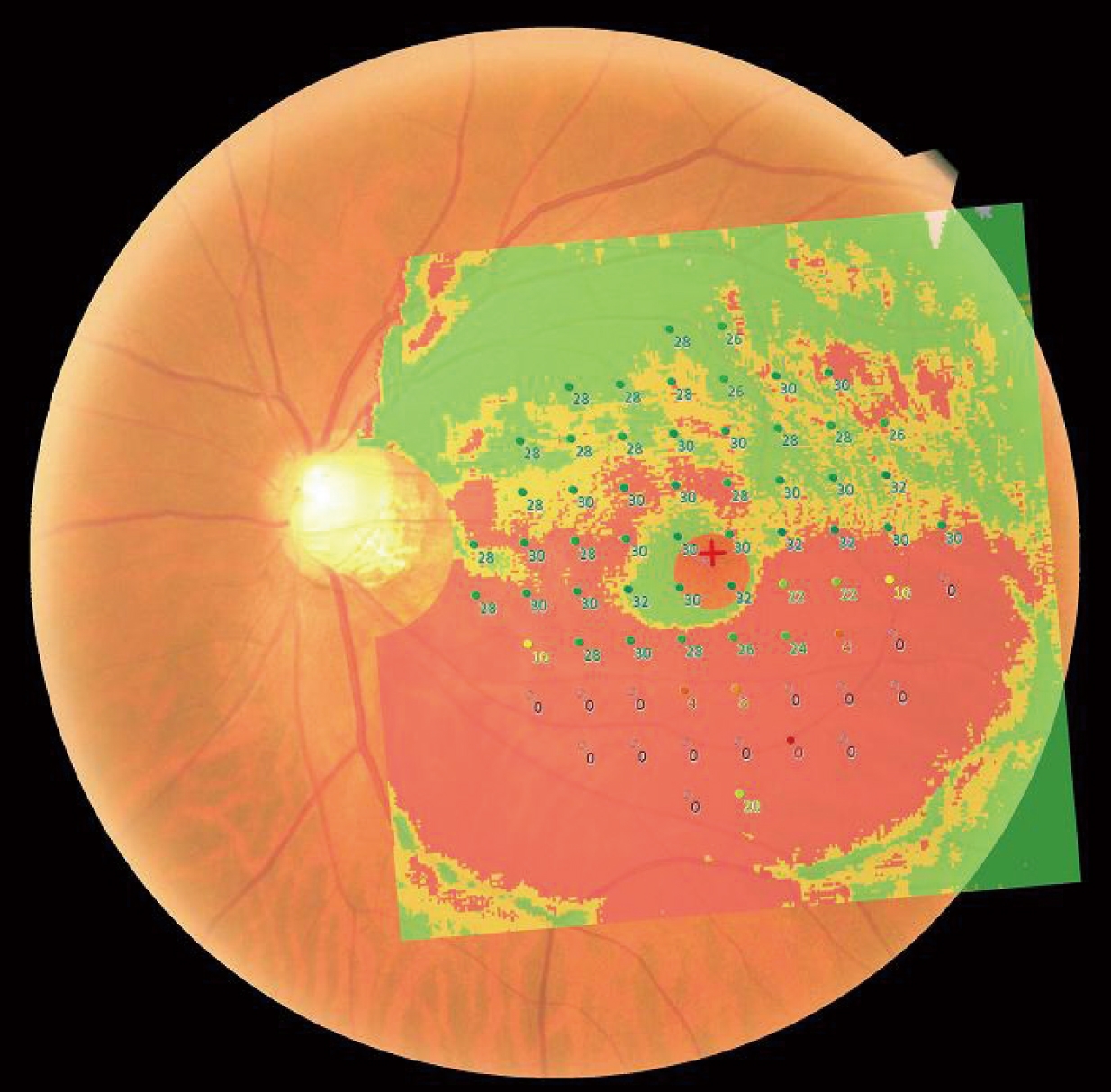
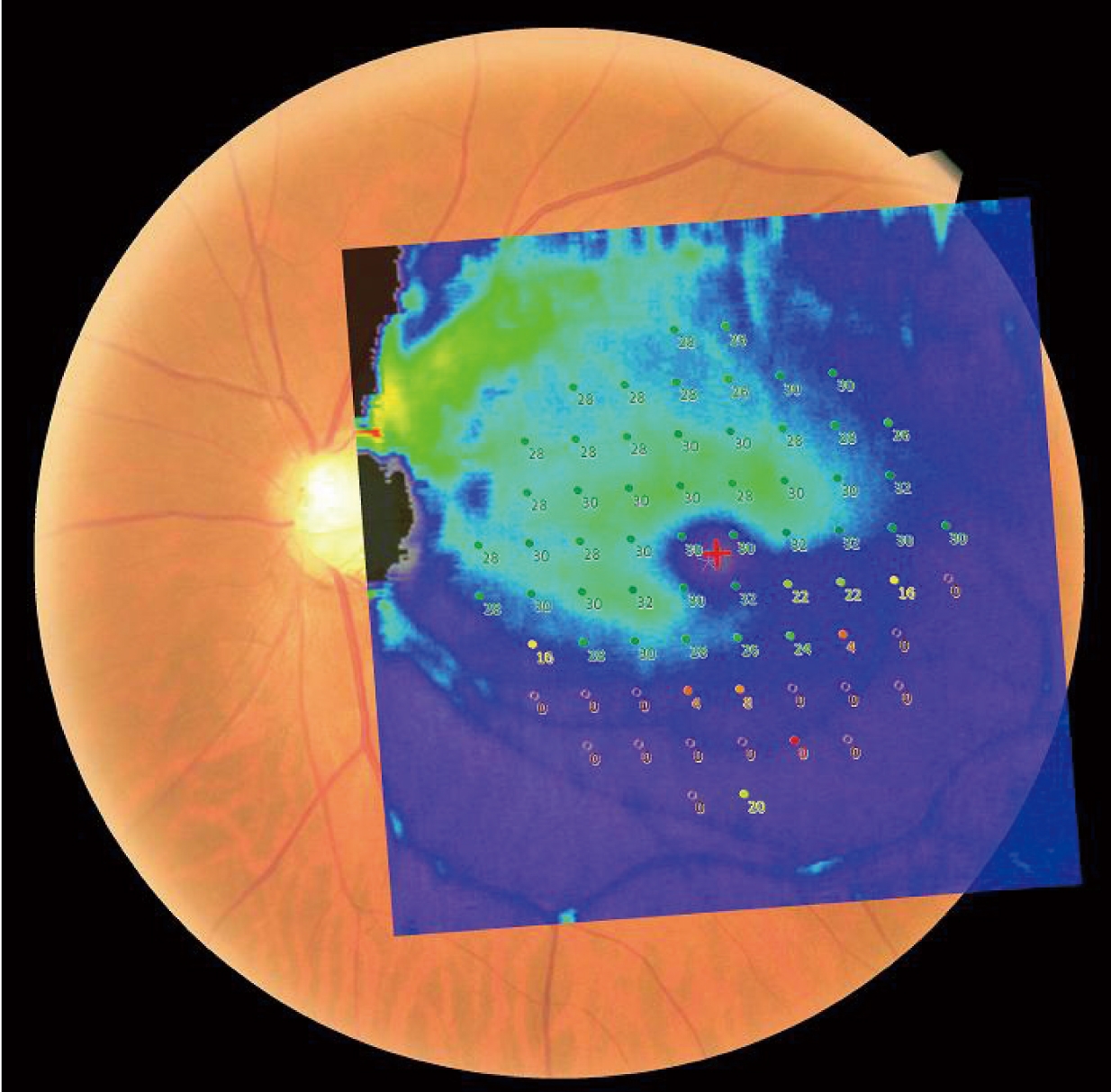
Luigi Sacco Hospital, University of Milan, Italy
Doheny Eye Center, UCLA, USA
Retina Foundation & Eye Research Center, India
Exilaser Clinic, Peru
Stanislao Rizzo, MD
Professor, Head of Unit of Ophthalmology
Fondazione Policlinico A Gemelli IRCCS & Università Cattolica Sacro Cuore, Italy
The Mirante multimodal imaging platform integrates multiple clinically significant imaging technologies into a single platform. With this device, clinicians have access to a wide range of imaging modalities including color fundus retinography (SLO), contrast angiography (fluorescein and indocyanine green angiography), green and blue fundus autofluorescence, OCT, OCT angiography (OCTA), and finally the new Retro mode technique. Registration and tracking software allows greater correlation of anatomy, structure and function of the various modalities in this all-in-one device. Additionally, software integration with the NIDEK MP-3 microperimeter can be performed, to correlate (overlay) visual function to structural changes.
The inclusion of ultra wide field imaging allows enhanced evaluation of chorioretinal pathologies involving the periphery, allowing better patient management.
SriniVas R. Sadda, MD
Director, Artificial Intelligence & Imaging Research, Doheny Eye Institute
Professor of Ophthalmology, The University of California – Los Angeles (UCLA), USA
The Mirante platform is a versatile multimodal imaging tool which has proved to be invaluable for diagnosis, staging and management of various retinal diseases in our clinical practice. I have been impressed by the SLO true color fundus photography which provides an accurate color rendition but also offers better contrast and clarity compared with traditional flash color photography. One unique imaging modality of the Mirante device that has been of particular interest to our group is Retro mode imaging, which produces especially high-contrast images with a pseudo-three-dimensional appearance that enhances our ability to detect fine and subtle retinal abnormalities. Notably, the Retro mode and SLO color, as well as other imaging modes (e.g. green and blue fundus autofluorescence, indocyanine angiography, fluorescein angiography) can also be acquired using a wide-angle lens allowing the full extent of the pathology to be evaluated. OCT and OCT angiography are additional Mirante modalities that we have found to be of benefit. Overall, the Mirante is a powerhouse device that allows us to comprehensively assess retinal diseases in our patients.
This product is not cleared by the FDA for distribution in the United States.
Akihiro Ishibazawa, MD, PhD
Manager of Department of Ophthalmology, Japan Red Cross Kitami Hospital, Japan
The Mirante multi-color scanning laser ophthalmoscope (SLO) easily captures high-quality images of the posterior-pole and widefield images even in the presence of media opacity. The field of view (FOV) on a single wide image is adequate for documenting the findings of retinal vascular diseases. Changing the fixation target or device angle enables documentation of peripheral retinal breaks and retinal detachment.
Furthermore, macular imaging can be documented in exquisite detail, as can retinal folds due to epiretinal membrane, glaucomatous cupping of the optic disc, and focal retinal nerve fiber defects, etc. As an added benefit, the Mirante performs fluorescein/indocyanine green angiography on the same axis as the color SLO allowing direct correlation of structure to function. The addition of OCT and OCTA allow a thorough analysis of retinal structure and comparison to normative databases. Mirante is a promising new-generation multimodal imaging device for daily use in clinical practice.
Gerardo Garcia-Aguirre, MD
Attending physician, Asociacion para Evitar la Ceguera en Mexico
Clinical professor of Ophthalmology, School of Medicine and Health Sciences, Tecnologico de Monterrey, Mexico
The NIDEK Mirante is a very convenient and practical device for obtaining images of vitreoretinal pathology using different imaging modalities in the same device. It saves both me and the patient the time and hassle of moving between multiple devices. I like the customization capabilities (adjustable scan area and image quality) that I find are beneficial and allow the quick acquisition of images with exceptional resolution in cooperative patients and in patients with poor fixation. Furthermore, the Mirante has some unique, clinically important imaging modalities that are not available in other devices, such as the infrared Retro mode to visualize drusen, and the ultra wide-field infrared SLO to visualize vitreous floaters.
Manish Nagpal, MD
Senior VR Consultant, Retina Foundation, India
Being a laser based SLO device, it allows seamless capturing of great quality images without the requirement of dilation. It is extremely efficient, user friendly, and takes reasonably good images even with dense cataracts.
The ability of Mirante to capture multimodal images allows us to show these to the patients and help counsel them based on their pathologies. It gives us great insight into various retinal pathologies and helps us make accurate treatment decisions.
Moreover, its ability to capture a wide range of images helps us document a lot of images academically, which can be used for teaching as well as sharing on various CME forums to enhance knowledge.
Fabio Patelli, MD
Director, VitreoRetinal service, ASST Santi Paolo e Carlo Hospital, University of Milan
VR consultant, Advalia Vision, Italy
Mirante has all the advantages a physician prefers: high quality images from the SLO, acquisition of wide field images without dilation, increased efficiency for clinical workup by incorporating OCT, OCT-A, Fluorescein Angiography and ICG, fundus autofluorescence and Retro mode all in one device.
Multimodal imaging is now essential for medical retina and Mirante is the first device that incorporates all these characteristics for enhanced diagnostic screening. The high-quality wide field images are fundamental for resident training and patient education.
Shozo Sonoda, MD, PhD
Director, Kagoshima Sonoda Eye Clinic & Plastic Surgery
Visiting Professor, Department of Ophthalmology, Kagoshima University, Japan
The evolution of fundus imaging equipment has been remarkable with the current devices enabling rapid acquisition of high-definition retinal images. While this benefits patients through improved diagnostic outcomes, there is issue of “physicians having to assess an ever-increasing quantity and variety of medical images” and the related possibility of overlooking important details.
Mirante is at the forefront of addressing this issue. For example, as a multimodal device the Mirante acquires high-definition, ultra wide field fundus images that presents more information than conventional fundus cameras. Understanding the principles of this scanning laser ophthalmoscope (SLO) and familiarity with image interpretation enables timely and efficient identification of subtle retinal lesions without overlooking important characteristics. Additionally, the clear high definition images generated by the Mirante facilitate easy patient education thereby encouraging them to participate in treatment.
Nikolle Tan, MD
Consultant Eye Surgeon, Asia Eye Centre, Singapore
The Mirante is a sleek all-in-one machine that makes multimodal imaging for retinal diseases a breeze. With its high definition confocal SLO, OCT, and OCT-A functions, the Mirante is a reliable and consistent workhorse that should be the foundation of any busy Retina practice.
It also comes with an exceptional number of other valuable functions, including ultra-wide-field imaging options, fundus autofluorescence and Retro mode. I find the ultra-wide-field imaging capability of the Mirante particularly indispensable, as in addition to ultra-wide-field color fundus photography, the system also allows for ultra-wide-field simultaneous FA and ICG.
The learning curve for using the Mirante is not steep, and together with Mirante’s excellent technical support team who also spares no effort in training users of this machine, it is easy for anyone, even a junior technician, to acquire consistently quality images.


